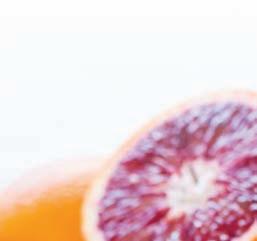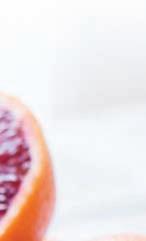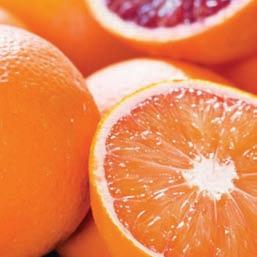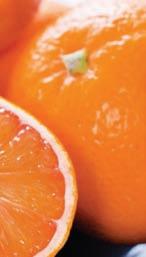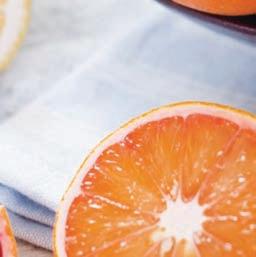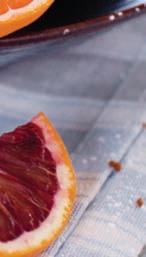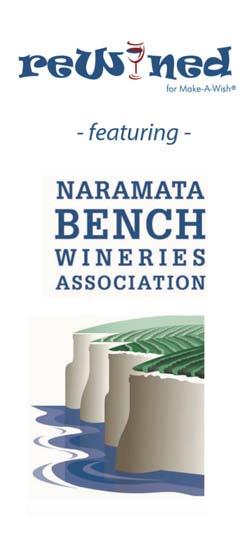Grain

Geeks
Island

Grain

Geeks
Island

on this coast and all around us are the first signs of new growth and fresh beginnings. I look forward to the start of halibut season, that first taste of wild nettle soup which seems to embody all that is spring freshness in a bowl, and how signs of life are returning to our streets. There are more cyclists, dog walkers, coffee drinking outdoors, and my walks along the Dallas Rd. waterfront trail are less bracing and so more meandering and easy-going. This is the time of year that Victoria really shines.
In this issue, we highlight this tricky season - we’re not quite finished with winter, yet not quite there for spring. So we write about how to put together a big salad that’s fresh and seasonal, but substantial enough for your dinner. Love spice? There’s a halibut curry recipe that will wow you with it’s bold and rich flavours and is right in step with the mid-March opening of the halibut season. You get the idea - fresh tastes substantial enough for the still chilly nights.
Elsewhere, we explore how bakers are increasingly turning to building and running their own mills to improve the quality and freshness of their flours. Plus we offer a quick guide to the top bread in the city. We also visit the home of Cory Pelan, owner of Victoria’s Whole Beast, for a peek inside his kitchen, and we go behind the scenes of what it’s like to be a young wine rep on Vancouver Island (hint: lots of travel, camaraderie and beer). Quick, what’s your favourite pastry? No doubt many of you said pie. That’s why we decided to extol the glories of pie making. Check out Ruth & Dean’s sugar cream pie on page 24 for inspiration. Good eating!
GARY HYNES FOUNDER & EDITORHearts were broken when news spread that Relish was closing but were quickly mended when word got out about the new Kitchen by Accio
Four great chefs (including Jamie Cummins of Relish) sharing one space and offering four menus; Bistro, Relish, Burgers and Italian, “built for speed, affordability and delivery in mind.”
MYACCIO.COM/THE-KITCHEN
The Salt and Pepper Fox has relocated from the teeny-tiny space on Johnson St and has opened a lunch counter and café at 1812 Government St (formerly Cascadia Bakery). Open Mon-Fri 8am-6pm and Sat 9am-6pm. FACEBOOK.COM/THESALTANDPEPPERFOX
Change is afoot in Fernwood, where the Cornerstone Café has closed and the space has been taken over by the Parsonage Café. The Parsonage had been in its previous location on North Park for 27 years. 1301 Gladstone Ave. FERNWOODCOFFEE.COM
Excitement is building for Shane Devereaux’s (Habit) new project, Sherwood. With a planned opening for June, the space still under construction at the corner of Douglas and Pandora will be a full service restaurant featuring indoor seating for 55 and an outdoor patio. Stay tuned for further details.
Congratulations to Alberto Pozzolo and the whole team at the Italian Bakery: 2018 marks the anniversary of their 40th year in business. This family-owned and operated, multi-generational bakery has been providing Victoria with delicious Italian and French-style breads, cakes, pastries, wedding cakes and event catering since 1978.
ITALIANBAKERYVICTORIA.COM



There’s a new slice in town. Fernwoodians will now be able to get craftstyled pizza at the Fernwood Pizza Company located beside the Fernwood Inn. Look for pies like Pepperoni/Mushroom, Coconut
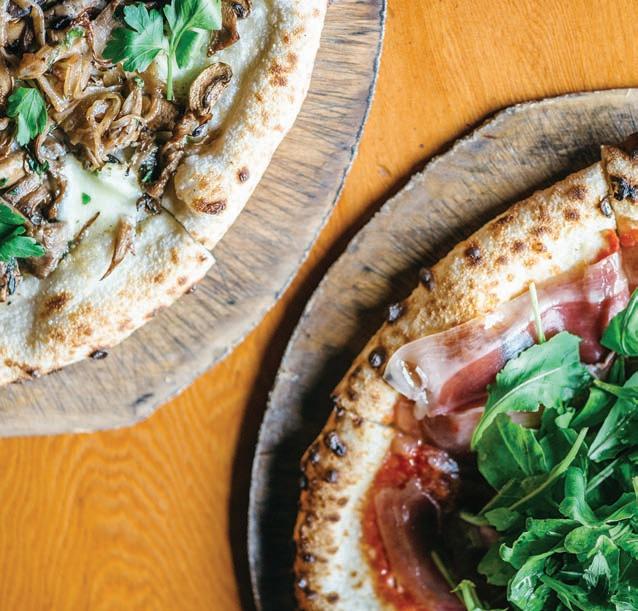
FERNWOODPIZZACOMPANY.COM
Cenote Restaurant & Lounge has opened Sidenote Cafe & Book Store.
CENOTELOUNGEVICTORIA.CA
Sizzling Tandoor's downtown location has undergone a major renovation and has reopened with extended hours, a late night feature menu as well as their entrance onto Victoria's cocktail scene. Their bar now features a drink list that includes a unique twist as Victoria's first Indian inspired cocktail bar and restaurant.
SIZZLINGTANDOOR.CA
A new venture for the Root Cellar sees the further expansion of their retail space, from just 4500 square feet when they opened in 2008 to an 11,000 sq. ft. locally focused shopping experience with the addition of their new coffee space, The Coffee Project. Opening in late March, The Coffee Project will embody the Root Cellar’s local focus, offering wholesome breakfast, lunch and snack options to go, in addition to serving locally roasted Discovery Coffee featuring a special Root Cellar blend, Silk Road teas, and locally made cold pressed juices.
THEROOTCELLAR.CA
The Magnolia Hotel & Spa will be unveiling a new restaurant, The Courtney Room, this spring. Chef Sam Harris (Agrius) brings a classic French twist to Canadian ingredients in an elegant, new space. Chef Harris helped set the bar for Victoria’s flourishing culinary scene when Agrius was listed in enRoute’s 2016 Best New Restaurants Top 10 with him at the helm, and he will continue to innovate with a menu that honours local farmers and flavours. The Courtney Room will be open every day and night to provide a genuine welcome to visitors and locals alike. MAGNOLIAHOTEL.COM
Victoria Beer Week is a nine-day festival of events highlighting a broad selection of BC craft breweries while educating Greater Victoria residents about craft beer. VBW is fuelled by events that pair BC craft beer and local Victoria artisan food vendors, with a clear focus on showcasing quality BC craft beer and educating beer enthusiasts. Smaller tastings, seminars and micro-events happen at various venues throughout the week. Mar 2-10
VICTORIABEERWEEK.COM

The seventh annual Culinaire event will be held
in the main building of the Victoria Conference Centre on March 8 this year. This event provides locals with the opportunity to savour signature menu items and inspired dishes from an abundant selection of restaurants, lounges, pubs, cafes, specialty purveyors, and sip from a fine selection of local and regional wine, cider, and craft beer. Partial proceeds provide scholarship awards to the Camosun College Culinary Arts Program and a donation is made each year to the BC Hospitality Foundation
CULINAIREVICTORIA.COM
The Surfrider Foundation Fundraiser will take place in Tofino March 9 at the Wickaninnish Inn. The exclusive fifty-person fundraiser evening will be the first event hosted in the newly renovated Salal Room. The event will include pre-dinner canapes, a 3-course seated dinner, cheese and sweets post-dinner all created by The Pointe Restaurant’s Executive Chef Warren Barr. Tickets are $150 per person with all ticket and auction proceeds donated to support Surfrider Foundation Pacific Rim initiatives. 1.250.725.3100
On April 5, Souper Bowls of Hope will be holding its 20th fundraising event at the Victoria Conference Center. The concept is EAT SOUP / HAVE FUN / KEEP THE BOWL. Soups will be created and served by chef Morgan Wilson of the Empress Hotel, chef Nicolas Hipperson of the Union Club, chef Marcelo Najarro of 10 Acres Bistro and chef Cheryl Schultz of Cheryl's Gourmet Pantry accompanied by
Portofino Bakery Bread. Music provided by the fabulous Vic High R&B band. Guests get to take home a beautifully hand crafted bowl donated by local pottery artists. All funds go to support Victoria Youth Empowerment Society. This year's funds will have a focus on a new program on Gardening - where the Youth can learn to grown vegetables, herbs and use these ingredients in the Youth Can Cook program that ties this concept all together. SOUPERBOWLS.COM
ReWined is a new fundraising event for MakeA-Wish BC & Yukon featuring the Naramata Bench WineriesAssociation (NBWA). Guests will have the opportunity to sample an exclusive spring release portfolio from select wineries while enjoying local fare, live entertainment and a silent auction, all while helping change lives for local children living with critical illnesses. April 10 at the Crystal Garden. Tickets $100.
MAKEAWISHBC.CA/NARAMATA
Local food and beverage businesses, including Pizzeria Prima Strada, signed on as sponsors for the Impact Sustainability Travel and Tourism conference,which took place in Victoria in January. Impact is driven by a desire to align all segments within the Canadian tourism industry, as well as stakeholders throughout our communities touched by tourism, behind a collaborative vision to achieve economic, social and environmental sustainability. TOURISMVICTORIA.COM/IMPACT
Masthead
FOUNDER & EDITOR
Gary Hynes
PUBLISHER
Pacific Island Gourmet
CONTRIBUTING EDITOR
Carolyn Bateman
VANCOUVER CONTRIBUTING EDITOR
Julie Pegg
SENIOR WINE WRITER
Larry Arnold
PRODUCTION
Gary Hynes
DESIGN CONSULTANT
Aleya Samji
COPYEDITOR
Cynthia Annett
REGIONAL REPORTERS
Tofino Ucluelet, Jen Dart
Victoria, Rebecca Baugniet
Cowichan Valley-Up Island, Kirsten Tyler
Vancouver, Jennifer Carter
CONTRIBUTORS
Larry Arnold
Joseph Blake
Michelle Bouffard
Isabelle Bulota
Marie-Eve Charron
Cinda Chavich
Pam Durkin
Lillie Louise Major
Sherri Martin
Elizabeth Monk
Daniel Murphy
Daisy Orser
Elizabeth Nyland
Adrian Paradis
André Rozon
Adrien Sala
Shelora Sheldan
Shawn Soole
Jill Van Gyn
Johann Vincent
Rebecca Wellman
COVER
Marie-Eve Charron (styling) & André Rozon (photo)
ADVERTISING DIRECTOR
Gary Hynes
SENIOR ACCOUNT MANAGER
Susan Worrall
MARKETING DIRECTOR
Ron Metella
FACEBOOK/EATMAGAZINE
TWITTER/EATMAGAZINE INSTAGRAM/EATMAG
For advertising and other inquiries: PHONE 250.384.9042, EMAIL editor@eatmagazine.ca
ONLINE EatMagazine.ca, TheEatJournal.com
MAILING ADDRESS Box 5225, Victoria, BC, V8R 6N4
STOCKISTS EAT is delivered to over 300 pick-up locations in BC. Visit our website for locations.
PRINTED IN BRITISH COLUMBIA
EAT ® is a registered trademark.
Est. 1999





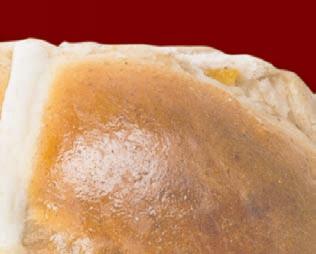

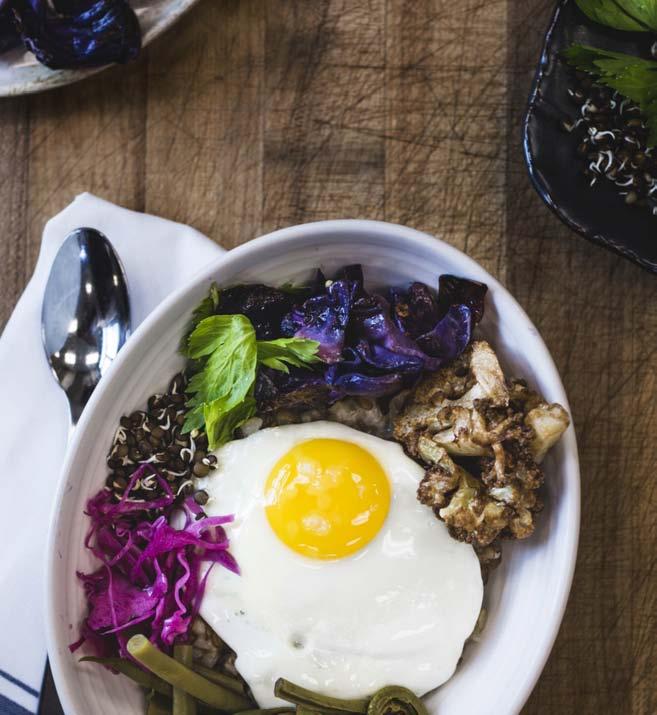






AS SPRING ROUNDS THE CORNER, I reflect on the Lancashire hotpot I had in a rural Midlands pub last April. The trees were in early leaf and the days cool enough for a scarf and sweater but pleasant enough for noshing out of doors. The steaming hotpot arrived at my spot on a long wood table with a wedge of tangy crumbly Cheddar and a pint of bitter. It was an ideal segue into spring, the lunch at once comforting but surprisingly uplifting—not at all stodgy. I am in Vancouver this year. The weather is not unlike that English day and I have a hankering for that hotpot.
Lancashire hotpot is a casserole of sorts—layers of lamb, carrots and onions slow-cooked in a kidney dotted gravy under a blanket of thin-sliced, crispy potatoes. (Oysters were also integral to the dish back in the day.) On a misty, warmish Saturday I set out in search of ingredients to make my hotpot. The Nat Bailey farmers’ market stalls brim with chunky, crunchy carrots, new potatoes and sweet onions. Three market vendors sell lamb roasts, chops and shanks all from naturally reared lamb. What a traditional hotpot calls for, though, is lamb neck. One vendor says sorry. He had whole necks earlier, but a
chef snapped them up. There are no kidneys. So I simply ask around. Jackson’s Meats (on 4th Ave.) will happily put aside the neck and breasts from their next delivery of a whole lamb. A friendly fellow at Windsor Quality Meats (on Main Street) offers to order in some necks. But I need them pronto.
I get lucky at Columbus Meat Market (on Nanaimo), owned by three Italian brothers. I speak with Eugenio on the phone, but it is Vito who cuts up lean shoulder, saws meaty necks and wraps up glossy, tender fresh kidneys the colour of good Burgundy and still attached to thick white suet. At home I check out recipes. British chef and Lancashire native Nigel Haworth’s on-line, upmarket hotpot looks and probably tastes splendid, the kidneys waived and the lamb loin placed jauntily atop the potatoes. I decide to go old school, cribbing from a neck-ofmutton recipe that also includes leeks, which I include too. My straightforward hotpot, though hardly photogenic, tastes absolutely spot-on.
I chose to launch spring with a Lancashire hotpot due to my fond memory, because it was not quite shirtsleeve weather and because I have never made it. But mainly it was because the




smell of lamb is the smell of spring. As the season moves along, I will welcome a Sunday joint as the British call a roast, with mint sauce, tiny sweet peas and new potatoes (followed de rigueur a day or so later with shepherd’s pie from leftover, hand-minced lamb). The Jackson’s Meat neck will go into an Irish stew. The breast is for Elizabeth David’s bread-crumbed Lamb Ste-Ménéhould, a rustic French recipe I found in my dogeared copy of an Omelette and a Glass of Wine. Although an uncomplicated dish, I like the idea of taking the better part of an afternoon to prepare it.
Which brings me to other countries’ lamb dishes. There’s nary an ethnic vegetable, legume, herb or spice that shies away from lamb. I can slice into Greek- inspired, slow-roasted lamb stuffed with pine nuts and eggplant as outlined in James Villas’s American Taste. Or look to Persia as James Beard and Elizabeth David (again) do in The Armchair James Beard and Is
BY FOL EPI
The delicate flavour of spring lamb is a harbinger of the verdant season.
There a Nutmeg in the House respectively. He bakes lamb with rhubarb and cinnamon. She stuffs apples with minced lamb and cumin. I can christen my recently purchased tagine, the vessel, with Jamie Oliver’s Moroccan tagine, the stew. Lamb and chickpeas are served over couscous, spiked with apricots, olives and almonds. Alice Waters’ kidney risotto with artichokes and Fergus Henderson’s kidneys sautéed in their suet coats with watercress salad are must-tries. But in the meantime I will haul out and wipe off a lawn chair, don scarf and sweater and hunker down with my hotpot, perhaps with some pickled cabbage (a traditional add-on), a wedge of Clothbound Cheddar from Farm House Natural Cheeses in Agassiz, a mug of bitter from Gibsons’ Persephone brewery and drink in the early spring air.



Wines of distinction that are an intensely avoured expression of our 50 year old vineyard.






THE BANANA WE KNOW AND LOVE (along with the rest of the world; annually more than 100 billion bananas are eaten globally) is the Cavendish variety, spoiling us with its bright yellow peel and ivory flesh with balanced starch and sweetness. However, bananas aren’t revered as one of the world’s divine foods because of Cavendish alone. Other varieties you may find at local markets this time of year offer the palate a spectrum of delights.
RED: Most often imported from Guatemala, Red bananas offer a different nutritional profile high in carotene, Vitamin C and amino acids. Its flesh is sweet with a hint of berry and is a creamy to pink hue when ripe. They are ready to eat when their skins becomes a deep chestnut-red colour.
THAI: Under-loved because when ripe their peel is covered in black patches, this variety (most often actually imported from Mexico) is extremely sweet and has a smooth creamy texture when ripe.
BURRO: Sometimes called the “chunky banana,” as it is stubbier and squarer than most bananas, the Burro’s peel is a deep rich green that turns deep yellow with black spots when ripe. A ripe Burro is creamy and sweet with lemony undertones, but it retains a


slightly crisp textured centre, though like a plantain, it can be used at varying stages of ripeness; if you are looking for a tangier taste, eat it sooner.
MANZANO “APPLE”: Stubby “finger variety” of dessert banana (as all sweet varieties are referred to) has thick, golden-yellow skin. It has a unique taste with hints of apple and berry if you eat it when dark yellow.
NIÑO: A dessert banana though much smaller than a Cavendish (making it a favourite of children), the Niño offers a much sweeter flesh, making it a lovely quick snack. Most often imported at this time of year from Ecuador, Guatemala or Costa Rica.
PLAINTAIN: Often larger in size, with more square sides than a Cavendish, plantain is not considered a dessert banana because of its lower sugar content and higher starch level, which is similar to that of a potato. Plantain is more commonly prepared as a vegetable and is lovely fried alongside almost any Central American meal. It can be prepared at varying levels of ripeness depending on the application.
Our darling Cavendish, however, is in danger. The banana as we know it is the result of an ancient sterile hybrid of two undesirable varieties that for centuries have been enjoyed and propagated for our benefit. An otherwise evolutionary dead end has been avoided by



ongoing cultivation by diligent farmers, only possible using cuttings from other plants. Every Cavendish banana is therefore genetically identical, delivering all of the consistencies we have grown to expect. However, this also renders them extremely vulnerable to disease; and disease is coming.
Cavendish only stepped to centre stage in the 1950s when the formerly dominant, and apparently superior Gros Michel variety, was ravaged by Panama disease and rendered commercially extinct. Cavendish was waiting in the wings as the “next best bet” for mass cultivation but is currently under threat by the same devastating fungus. It is speculated that the Cavendish could become unsuitable for cultivation in the next 10 to 20 years, and although there are many other banana varieties cultivated worldwide, none has the same commercial appeal and viability.
This is bad news for bananas, bad news for our fruit bowls and could prove devastating for economies in growing regions, not to mention the impact on those cultures that rely on bananas as a dietary staple.

While the custodians of our beloved banana toil to secure its future, we can contribute to banana diversity and sustainability by broadening our banana palate. Try a hand of new bananas; take the pressure off this monoculture and increase demand for currently more obscure varieties. Your contribution will be valuable— and delicious.


We learn about life on the road, the zipper merge and TGIF
story by PICO WHITTIER AND TAYLOR BULL photography by SHERRI MARTINico Whittier and Taylor Bull are passionate young wine representatives working in the same territory: beautiful Vancouver Island from Victoria to Port Hardy. They rep for different agencies but shun the usual competitiveness alive and well in most professions, helping each other out whenever they can to offer the Island interesting new wines and spirits. In the following story, the two women offer a glimpse into one of their working weeks, in their own words.
Being a wine rep isn’t as glamorous as it may seem despite the glamorous product. It’s 5:30 a.m. on a Tuesday, and I’m on top of the Malahat, off to a meeting in Courtenay, three hours away from home. I’ve already dropped my toast and avocado on my dress, spilled coffee on the passenger seat and a bottle of prosecco I had in the trunk has exploded all over my freshly printed portfolios. Welcome to my office of blood, sweat and tears—my car. It’s a hot mess.
Bean Around the World coffee shop in Ladysmith is the first stop on my Island adventure. I order the perfect iced Americano and bolt out the door. I still have another two hours on the road. The exploded prosecco aroma that wafts from my trunk sure doesn’t smell as good as it tastes. I pray I won’t get pulled over for any reason because it smells real boozy in this vehicle and it’s only 7:30 in the morning.
I often feel isolated having the rest of my wonderful team at Select Wine Merchants based out of Vancouver, but I’m reminded every day of the beauty of this Island and the consistent support within the wine community; I feel so lucky. There are more than 10 wine festivals on Vancouver Island alone. These events are usually two-day ordeals providing both a trade and public portion. Yes, they’re on weekends and extremely hard on the feet, but they’re also some of the most entertaining days of the year. It is always fun being surrounded by other sales reps and educating the public on unique wines. (Sorry, Vancouver—we all get along here.)
Throughout the day I stop into my accounts where I sell Prosecco, Chianti, Bordeaux and Champagne—just a few of the wines from around the world that I adore, and so proudly represent.
Having arrive in Courtenay, my home for the night is none other than The Old House Hotel, which houses one of my favourite restaurants on the entire island: Locals at the Old House. Here I will meet Taylor, where we share laughs from the day, sales rejections, challenging drivers on the road and the happy moments when we give those not directly involved in the wine industry the opportunity to taste something new and exciting.
I believe it takes a very unique personality to enjoy putting more than 40,000 kilometres on their vehicle each year. It takes a personality that craves new surroundings, enjoys new challenges and absolutely loves the hospitality industry. As a sales rep for The Drinks List Merchants, based out of Vancouver, I represent a handful of wines, spirits, craft ciders and beers throughout the 31,285 square kilometres of Vancouver Island. I do not live the Monday to Friday, 9-5 career lifestyle. Instead, I find myself in a new restaurant or liquor store on the daily.
No single day is similar. Yesterday afternoon I escaped the lunchroom, a.k.a. my vehicle, and enjoyed my Tupperware lunch on the shoreline of Port Sidney Marina. I continued my hunt for Vitamin D to the beautiful ambiance at Sea Glass Waterfront Grill in Sidney. Here I enjoyed the unique views of the marina as I worked with the staff to partner my new wines with their continuously changing menu. Wow, this rose pairs perfectly with a sailboat named Limelight “office today.
Tuesday brings me to an entirely new territory. I have travelled the Old Island Highway straight up to Courtenay while stopping in to visit my business accounts along the way. Many islanders bypass the “Oceanside Route” while wandering north. Little do they know that the extra 30 minutes of travel will deliver spectacular ocean views and numerous family-owned coffee shops. Why would you ever pass up a drive with a view?
Lunch today is at the Cumberland Brewing Company. Most of my days are surrounded by wine, so enjoying a tall pint of Cumberland’s Red Tape pale ale craft beer really hits the

SOMETHING NEW AND EXCITING IS HAPPENING IN TROUNCE ALLEY. Chef Seongbea Park is celebrating his Korean culinary roots. Park opened Sushi Island across from Hillside Mall in 2013 and Park's Kitchen in Trounce Alley in October 2015. Before that, he worked for five years in several Vancouver kitchens, and before moving to Canada, Park majored in economics at a university in Seoul and worked in his family's restaurant where he learned to make noodles and traditional Korean sauces.
Park's Kitchen features many Korean specialities in addition to a wide-ranging menu of sushi rolls and cones, sashimi, donburi, tempura, bento box combos and noodle dishes. The 40-yearold chef and owner and his wife and business partner, Christina are now accentuating their Korean culinary roots at Park's Kitchen, launching a new menu with several bargain-priced Korean dishes during the restaurant's 11 a.m.-3 p.m. lunch service.
When I visited recently, I joined Christina at one of the restaurant tables and like all their guests were offered a complimentary cup of rice and green leaf tea. The 65-seat restaurant's booths are made more private with decorative wall screens, and the largest room includes a 10-seat banquet table and a flat-screen television in the back wall. Chef Park and his staff are visible working behind a half-wall that runs almost the length of one side of Park's Kitchen. There are also nearly a dozen seats at tables on the patio's wooden platform in Trounce Alley. "Would you like to try our most popular dish?" Christina asked as I perused the restaurant's extensive menu. "Canadian people like our Korean Barbecue Grill. You can choose chicken, pork, beef or squid, and you can choose the spice level from mild or hot to scorching hot produced with Korean Cheongyang chili peppers.

You can also have traditional Korean Fried Rice, Ramen or Udon noodles, which comes on a big pan that encircles the dish with cheese and corn. It's big enough for two," Christina added. "Maybe you should try the Farmers Meal. It's similar but smaller with steamed rice and vegetables, and you can choose between soy-based Bulgogi or spiced-based Jeyuk... but I think you should try Chef Park's Osaka-style, flame-seared, and pressed Oshi Sushi. It melts in your mouth. I love the salmon and the spiced tuna."
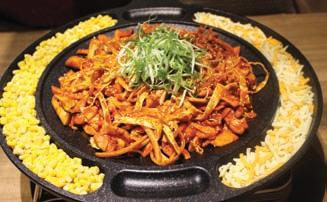

I chose the Oshi, and Christina ushered me into the kitchen to watch Chef Park torch several pieces of tuna that had been pressed into beds of rice and garnished with a homemade sauce, topped with slices of mild peppers and lotus root. It was delicious, and unlike any sushi dish, I'd ever eaten.
I'll come back to Park's Kitchen to try it again and to sample the new lunch specials like Spicy Pork and Spicy Chicken Fried Ramen, as well as Korean-style Hot Stone Bowl and Kimchi Hot Pot. I've got lots of adventurous eating to do in Trounce Alley. —Joesph Blake Park's Kitchen, 606 Trounce Alley 778-265-2227
Monday.-Saturday. 11:30 a.m.-10 p.m. Sunday 11:30 a.m;-9 p.m.
spot. Cumberland is a magical little town where there’s no shortage of fresh eggs and local produce. I often bring my mountain bike or hiking shoes with me on the road. I strongly believe there are just as many recreational trails covering Vancouver Island as there are paved roads. I find it very important to stay active when travelling for as many hours as I do by car.
Tonight I join Pico for dinner in Courtenay. Over a few glasses of wine, we decide to make up a list outlining the Rules of the Road, the Vancouver Island edition. This is what we come up with:
1. Finger food only. No utensils allowed.

2. Beware of rental cars. Seriously, pull over for a nap if you are following a Budget, National or Enterprise sticker.


3. Best takeout: Amrikkos Tadka Lounge in View Royal.
4. Never plan on driving through Duncan between 3:00-4:00 p.m. If so, tack an extra 20 minutes onto your journey.
5. Merge like a zipper. How has Vancouver Island not figured this out yet?

6. Best Vancouver Island Gas Station Bathroom Award goes to: The Co-Op just north of Cobble Hill.
7 Be sure to plan fun field trips into your day and support the 50 local wineries, breweries and distilleries conveniently placed across the Island.

Thursday 4:00 p.m.













One of our favourite watering holes in Victoria is Spinnakers Brewpub in Vic West.
Regardless of the weather, we always meet on the upstairs patio if it’s open. The blankets and patio heaters keep us warm alongside a well-deserved glass of local bubble and fresh bread. Although Spinnakers’ brews are great, it’s not what we come here for. We come for the chocolate. We are experts on the food, beverage and services geography of Vancouver Island. We can tell you where the best bakeries, takeout food and fitness classes can be found. Another glass of wine down the hatch and we move onto the final day of our week.
Thank God It’s Friday

We are shocked to bump into each other in the lobby of Villa Eyrie Resort on top of the Malahat, both loaded with wine samples. Uh-oh—it looks as if we’ve been double-booked. Do we arm wrestle or have a race towards the meeting room? For some reps this could be a major issue; for us, this is the perfect situation.

It’s as if the three of us had met together a thousand times before. We both sit down with Kevin, the wine buyer for the prestigious Summit Restaurant. Here we taste through both of our agencies’ wines together while the sun sets over the rolling hills around the Saanich Inlet. We plan a future event with Villa Eyrie’s Wine Society Social, which offers fivecourse dinners and wine pairings to the public. How lucky are we to be involved in unique events like this?
Five o’clock hits and Kevin runs to the cellar, returning with a splash of an Argentinian port-style Malbec to toast the end of a fantastic week and celebrate the incredible wine community we have here on Vancouver Island.
Wine is our passion, Vancouver Island is our paradise. To combine the two is lethal. We are the luckiest employees in the world.
Coffee and cream; peanut butter and banana; cheese and tea. Some things just go together, others do not. Cheese and tea together sounds absurd, but this drink, which originated in Taiwan around 2010, is for real. And it’s better than it sounds.
Sweetened green or black tea, served warm or cold, is topped with a frothy whipped cream cheese, the cheese taking the place of the tapioca pearls of bubble tea. The sweet and salty concoction slowly melts down into the drink, making for a unique drinking experience.

Early formulas used a cheese powder, which later evolved into real cream. In early November 2017, the cheese tea trend came to Victoria when Partea opened up at 1026 Blanshard St.
Partea is small, cozy, and trendy with its chunky wood and black metal tables and stools, overhead lights that mimic puffy clouds and a cutout cardboard frame you can take your picture in—complete with Instagram hashtags. Aimee Xu and Ling Lu are the welcoming, chatty co-owners of Partea. “It’s super-popular and a trending product in Asian countries right now,” says Lu. “There’s also a lot of cheese tea in New York or London, but we couldn’t find any in Victoria.”
Lu and Xu are both from China and were studying intercultural and international communication at Royal Roads University. After moving to Victoria, they said the only cheese tea they could find was in Vancouver and they didn’t want to travel so far just to have their favourite drink.
“Before we opened the store,” says Lu, “we spent half a year figuring
out which cheese tea was the best. We did a lot of private tasting tests in Taiwan and found a lot of local Victorians to taste our tea and give suggestions.”
The dense foam on top of the drink is decadently rich but is eventually mixed in to the tea. It is suggested that you forgo a straw (cities across the globe are banning the things as unnecessary and environmentally harmful anyway) and simply tip back the drink to experience both layers. At first you’ll taste just the richness of the cheese foam, but once the tea washes over, the drink mellows out into a complex experience of sweet and salty. The creaminess of the foam balances out the bitterness of the tea while bringing out some of the tannins and fruity flavours.
While Xu and Lu believe cheese tea is the next evolution of bubble tea, Graysen Dobbswall, manager of The Bubble Tea Place at 532 Fisgard, says he isn’t worried that bubble tea is going away any time soon. This is the first he has heard of cheese tea and, despite the new trend, his shop is booming. “We’ve been steadily busy, and if anything, we’re picking up business,” he says. “We have a lot of regulars now that come in every day.”
While Lu and Xu agree not everyone will try cheese tea, they hope Victorians will be inspired to sample something new. “Something like Starbucks or the Big Orange is more like fast food tea,” says Lu. “We are more of a luxury product. We spend more time on it. How we arrange the fruit, or how we put the cheese foam in the cup, it’s more like a painting in a gallery. It’s very beautiful.”
Partea, 1026 Blanshard St, Victoria,
ADRIAN
It’s an awkward request, to ask to poke a lens around someone’s fridge. And then, on top of that, to publish it for all to see. It’s a very intimate place, despite the hospital-grade fluorescents and sterile plastic shelving. But, like other intimate spaces, everyone has one, it’s usually a little grimier than we like to admit and most people have a phobia about openly comparing them to everyone else’s.
Cory and Madone Pelan, after some soul-searching, nervously agreed to put their gut instincts aside and opened their kitchen, pantry, fridge(s) and liquor cabinet to our prying eyes. Cory is the owner/operator of The Whole Beast and partner in the neighbouring Village Butcher, Oak Bay’s answer to all your carnivorous needs and/or wants. Madone is director of sales and marketing at the Oak Bay Beach Hotel and also lends these talents to The Whole Beast in her “spare time.”
About sixteen years ago, they moved from Yaletown to Brentwood, newborn daughter in tow, where “it was so quiet the crickets kept [Madone] up at night.” After moving closer to downtown Victoria, the local food scene and semblance of a nightlife made the transition a little easier. Cory established himself as a chef on this side of the Strait, and Madone took a position with
Since then, things have changed dramatically in the running of the Pelans’ home kitchen. The catalyst was Cory creating and throwing himself into The Whole Beast in 2011 extracting himself from the late-night commercial kitchen grind. Once the new business found a rhythm, Cory had the confusing pleasure of being at home before 6:30 p.m., “the polar opposite of what it used to be.” The importance of finding something approaching a “work/life balance” is written in his relieved face as he explains it. “I find myself loving to cook again. It’s not a ‘job’ anymore.” As such, he has taken the time to create a space both highly functional and conducive to cooking as pleasure. He dismantled the dining bar that stuck out from the wall into the centre of the room and reused the wood to build a central kitchen island with a cherry-wood surface (from West Wind Hardwood). A repurposed clothing dresser creates unique shelf storage and counter space. He teed the natural gas supply into the kitchen and installed a commercial-grade gas stovetop.
The first tools of his trade that I notice, given prime real estate at the workstation end of the kitchen island, are the knives. The varying handles protrude upwards from a long holder along
one end of a butcher’s block (go figure). All in all, Cory has around 150 knives, between the shop and home, in his collection. The prized ones are forged from infamous “Japanese steel,” purchased from Knifewear in Vancouver. The Victorinox collection gets a firm nod as well. Madone jokes that she is allowed to use only particular blades—some are off limits. At least, I took it jokingly. (Meanwhile, Cory has a very serious look on his face.)

There is a stacked bookshelf at one end of the room, and I glimpse some familiar names: Pepin, Au Pied de Cochon, Le Pigeon. Cory casually estimates that he has “only held onto a couple hundred” cookbooks. Interesting side note: Cory developed a taste for first edition cookbooks, which Madone explains “got ridiculously out of hand. I mean how many first editions of Larousse Gastronomique do you really need?” It helped dampen his enthusiasm when “professional pickers” started hitting up his go-to spots. But the Pelans still ended up with so many culinary tomes that they split what they could between the house and the shops, donated many back to the places they purchased them, and stored enough boxes under the house that by Madone’s estimation, “they are probably holding the place up.”

Some of Cory’s personal favourites: The Art of Living
According to Joe Beef, Harold McGee’s On Food and Cooking and True North by Derek Dammann and Chris Johns.

I ask Cory what his essential, must-have ingredient is: “Butter,” without flinching for a millisecond.
“Well, unless you have good quality lard, or duck fat, on hand.” Which he does. We chat about mustards, of which he says six to eight styles are a minimum necessity. Anchovies—but only good, European imports, in a huge jar (in this case from Chiarelli’s)— which he drains upon purchasing and refills with high-quality olive oil, then puts back in the fridge. “I do that for anything I buy in oil. It infuses whatever is in the jar or tin with the flavour of good olive oil. I sometimes add lemon juice or sherry vinegar.” For cheeses, and other deli items, Ottavio and Fig Deli. Also a (literally) healthy volume of vegetables take up the most fridge space, purchased at the Root Cellar, or Fairways for Asian-themed meals.
Although there are a couple of red-brown paper parcels of meaty goodness in the fridge drawer, there aren’t as many as one might expect of a salumiere/butcher. “Oh, we should go see the deep freeze. There’s a whole lamb in there.” And indeed there is. Not, as I originally imagined, in one piece, with its head and frozen death-stare still attached. But there is a beautiful abundance of local, ethically raised meat, expertly cut and stored: beef roasts, short ribs and steaks; pork chops, butts and roasts from “a really big Ossabaw pig”; wild boar, pork and

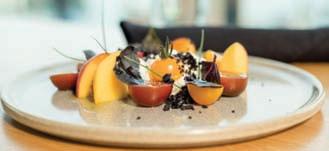

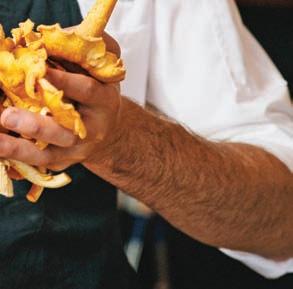



venison sausages; various stocks and soups; and “a few salmon I caught last summer both smoked and unsmoked.”
Despite this ease of access to superior-quality meat, the Pelan’s diet remains vegetable-heavy, protein-light and starch-zero. The kitchen is a carb wasteland: no breads, pasta, rice, potatoes. It’s not a rigid stance they cling to religiously, but it was a conscious decision that resulted in Cory effortlessly losing thirty pounds. As a result, the weekly menu usually boasts an organic roasted chicken dinner, a night or two of seafood (Oak Bay Seafood is conveniently located next to The Whole Beast) and a couple of dishes using dry-aged beef. But always with a generous amount of vegetables, “unless the girls are away. Then it’s the biggest steak I can get my hands on. And the best bottle of wine in the house.”
It’s a statement that holds some weight—their wine cellar is pretty impressive, due in part to Cory’s involvement in some of the kitchens during Victoria’s annual wine auctions. Their leanings are towards Okanagan (8th Generation, Kettle Valley, Synchromesh) and Island wines (Alderlea, Unsworth). Madone is partial to the Charme de L’Ile Prosecco-style sparkling wine, unique to the Cowichan and Salt Spring Island wine-growing regions. From there we peered into Cory’s extensive Scotch whisky collection: Springbank, Hazelwood, Bruichladdich, with the Octomore holding, for him, the most peaty, “dirty-hospital-tasting” joy. Cory is actually a Companion of the Quaich, an Illuminati-sounding private group that meets monthly to drink, discuss and purchase single-malt Scotch whisky. On the shelf above that, more bottles: “the staples,” for mixing up Manhattans and (new to me) “Torontos”— Canadian whisky, Fernet-Branca, bitters and simple syrup.
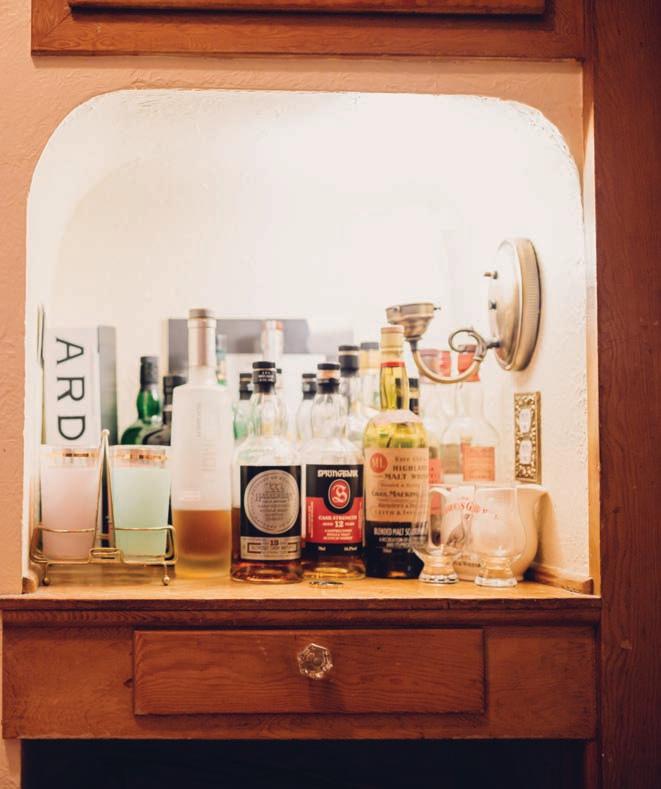
The Pelans have been so open, gracious and casual about us invading their private sphere, it’s as if they don’t even mind the extreme intrusion. As we swing the fridge door closed behind us, Madone gasps, “Cory, we left the cat food in the fridge!” Cat food, the Great Equalizer. Or, as Cory observes, raising his hands to his face in mock-horror: “Oh my God! People live here!”



Breakfast 8am-Noon | Dinner 5:30pm to close
Shared plates, family-style


If you share this somewhat limited view of an egg’s appeal, there’s good reason to become a little more “eggs-centric.” Eating eggs more frequently, in myriad ways, can enhance your family’s meals—and health.
Although eggs are not heralded as nutritional superstars, they should be. Besides being one of the rare sources of natural vitamin D, they’re also an economical source of high biological value protein. In addition, they house all the B vitamins, plus significant amounts of iron, molybdenum, phosphorus, zinc and hard-to-obtain trace minerals like choline, iodine and selenium. In fact, eggs are one of nature’s best sources of choline. That’s significant because a recent National Health and Nutrition Examination survey in the U.S. revealed that only 10 percent of the American population has an adequate intake of this key nutrient. Choline deficiency can cause high homocysteine levels, which have been linked to several chronic illnesses such as cardiovascular disease, osteoporosis and neurological diseases like Alzheimer’s. Here’s more good news about eggs’ nutritional profile—their yolks are teeming with disease-fighting carotenoids like lutein and zeaxanthin. These two antioxidants have been shown to reduce the risk for both cataracts and macular degeneration. Research suggests that lutein may also help prevent cancer. Studies indicate eating eggs regularly can increase the plasma levels of both of these health-enhancing phytochemicals by as much as 50 percent.
And though their cholesterol content was once vilified for its effect on heart health, current studies indicate that eggs may actually help promote heart health. Here’s how—eggs can help raise HDL (good) cholesterol and change the shape and size of bad LDL cholesterol to a more benign form.


Clearly eggs deserve to be showcased year-round and at any meal, not just breakfast. Whether they’re fried and placed atop polenta, oozing over pasta, tumbled into tacos, starring in a cheesy quiche or curried with rice, eggs can make lunch and dinner memorable too! Here’s just one “eggs-tra-ordinary” recipe to try!
4 medium-large zucchinis, shredded
Dash of salt
2 large carrots, shredded
1 Tbsp (15 mL) olive oil



4 large organic, pastured eggs
1½ cups shredded Jarlsberg cheese (or Swiss, Edam, etc.)
¼ cup (60 mL) chopped parsley
2 spring onions, chopped
1 clove garlic, minced
1 tsp (5 mL) dried basil
3 Tbsp (45 mL) grated Parmesan cheese
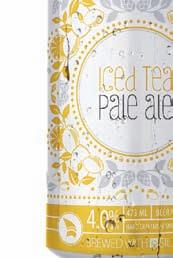

3 Tbsp (45 mL) dry-roasted sunflower seeds




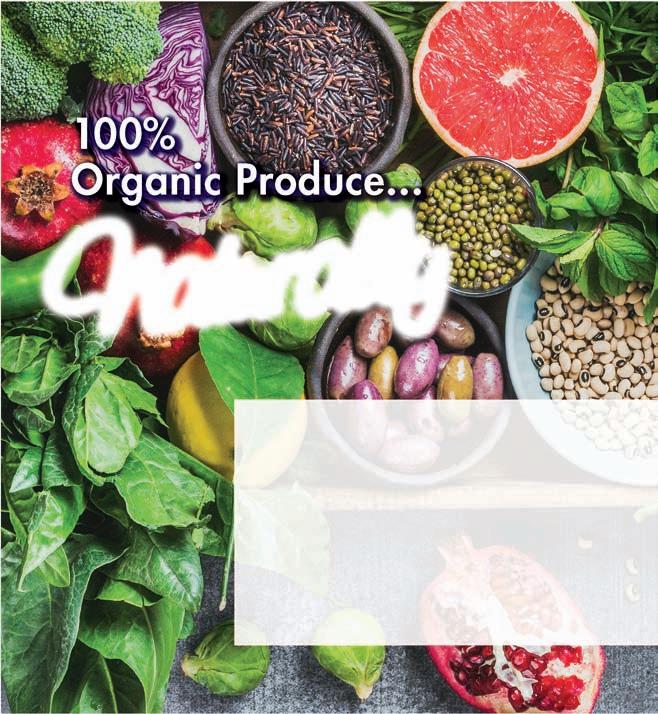
Preheat oven to 350ºF. Lightly grease an 11”by-7” baking dish. Place the grated zucchini in a colander and salt lightly. Let the zucchini

rest for 15 minutes. Squeeze out the moisture from the zucchini until it is quite dry. Pat dry the grated carrot.
Heat the oil in a large skillet over medium heat. Add the grated zucchini and carrot and sauté until crisp-tender.
Meanwhile, in a medium bowl, beat the eggs lightly. Mix in the Jarlsberg cheese, parsley, onions, garlic, basil and the sautéed veggies. Place mixture in the prepared baking dish. Sprinkle with the grated Parmesan and sunflower seeds. Bake for 30 minutes or until the filling is “set.” Remove from oven and cool slightly for a minute or two. Cut into squares. Squares can be served hot or cold.
IT’S IN OUR HANDS. HAND-CRAFTED BREAD MADE WITH FRESHLY STONE-MILLED FLOUR AND ONLY CERTIFIED ORGANIC OR SUSTAINABLY GROWN LOCAL INGREDIENTS . NATURALLY LEAVENED AND BAKED TO CRUSTY PERFECTION IN WOOD-FIRED BRICK OVENS. 1517 QUADRA ST.

Featuring local, all natural, free-range Deli meats and salamis

Quality meats, Poultry, Cheeses, Specialty Products & Condiments

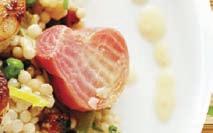
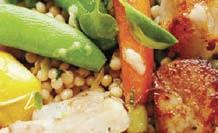




+ international-student-certified Taiwanese-Chinese food in University Heights.
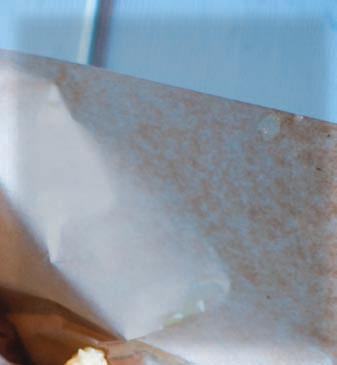
529 PANDORA AVE. NEAR WHARF STREET, VICTORIA | 778-433-9089
Victoria now has a taste of the southern U.S. of A. in in the new restaurant, Shanzee’s Biscuit Café. The former Solstice Café space has been re-invented as a deconstructed 1950s trailer park, but with beautiful touches like the Delft blue La Marzocco coffee machine and the wavy aluminum siding at the counter. The menu ranges from biscuits and gravy to biscuits and protein to biscuits and sweet stuff, and the prices range from $5.95 to $14.45. But first and most important, how are the biscuits?! Awesome. The dough is made by the revered Crust Bakery, and the biscuits are baked on site. They are like eating a scone merged with a cloud: soft, fluffy and pillowy. If I worked downtown, I would be coming in at 7:30 every morning for the Son of a Biscuit Egger for $8.95. The basic biscuit is filled with fried egg, Cheddar and choice of bacon, pork sausage or chorizo.
Vegetarians have a choice of a quinoa-lentil patty. If you want to go big, King of the Road for $14.45 boasts all things southern. Biscuit halves are topped with gravy—more on that shortly—and two overeasy eggs, and flanked by Louisiana, or andouille, sausage on one side and a mound of soft grits on the other. I sample the vegan mushroom gravy on one biscuit and the decidedly non-vegan sausage gravy on the other. Owner Shannon Stead credits Sean Brennan, former chef and co-owner of Brasserie l’Ecole, for the mushroom gravy recipe, which explodes with flavour thanks to tamari, nutritional yeast, onions and garlic. The sausage gravy is mild Italian sausage sautéed in cream. At home, I wouldn’t normally think of adding cream to my diced sausages, but it turns out to be a great combination and creates the felicitous experience of a dish with both sausage and sausage sauce. I’m all in! Diners with a sweet tooth can spend $5.95 on the Sweet Biscuit, which has the foolproof combination of Nutella, bananas and whipped cream. In short, the biscuits are far from basic at Shanzee’s Biscuit Café.

Canada’s “Provence” is just a hop, skip and a jump away. Replete with opportunities to slow down, sip and savour all manner of the artisanal and hyper-local, we are unassumingly tucked midway between Victoria and Nanaimo. Jump on a float plane, grab a ferry or take the short drive to our idyllic valley. But, don’t wait too long. We won’t stay undiscovered forever.









Culinary lemming that I am, where the international students go, I follow. This policy has led me to this Taiwanese and Chinese restaurant strategically situated between UVic and Camosun. The owners are Taiwanese, and some of the chefs are from mainland China, hence the diversity. The “House” in the name is purposeful. Owners and chefs Lee and Amy Lee want to create a feeling of home for students and newer Canadians from Asia, and they have been successful: even at 2 p.m., the restaurant is mostly full, and I’m the only non-Asian. What Taiwanese students can be most homesick for are bao. These mini Taiwanese sandwiches are trending right now in Canada but are classics in Taiwan. The restaurant’s bao for $12 are complex and sophisticated, with a pillowy pancake folded over seared pork belly with a tangy pickled cabbage relish, crushed peanuts and cilantro on top.
The most dramatic dish I have is the Sizzling Szechuan Tofu with Minced Pork, which arrives bubbling merrily on a cast iron plate. The base of the brown sauce is bean paste, which gives the sauce a sweetness, in the same way a miso paste would. Consequently, this dish is more sweet than spicy, despite the implications of Szechuan in the name. A need for spice can be met with Szechuan

Green Beans. The thick pepper and soy-based sauce clings to every single bean, creating an explosion of flavour. Finally, a student favourite is the House Special Chow Mein for $15, a useful dish for single diners because it’s an all-in-one: noodles, squid, pork, carrots, shiitake and lots of baby bok choi. I find the dish more practical than delicious, but I pep it up by putting some Szechuan green beans on top. Nonetheless, the staff assure me it’s a favourite with international students. Even if you’re not a homesick student, you will enjoy Lee’s House.
left: Choice of three kinds of Bao: pork belly (pictured with cilantro on top), crispy chicken (with grainy mustard sauce) and vegetarian.
 ELIZABETH NYLAND
ELIZABETH NYLAND












My international student Jitka from the Czech Republic, a meat and potatoes kind of place, says her dad always tells vegans he has a good recipe for them. “If you mix coconut oil into kale,” he tells his expectant audience, “it makes it easier to scrape it into the trash.” The daughter of this jovial cynic came with me to explore the vegan cuisine at this cheerful, friendly café, and her positive feedback about the café is telling.
If you’re going to put the word “chick” in your name, you are entitled, if not obligated, to use the colour pink liberally in your café. The pink walls of Vegan Hippie-Chick Café are complemented by black wainscotting and an eclectic mix of vintage velvet chairs and rickety 1970s school ones. The menu has the same sense of fun. Teas are named “Veganarchist” and “Yoga Tea,” and a mix of cacao, matcha, maca, coconut oil and almond milk is called “Vegan Brew.” The food menu is also playful; items are named like standard meat-based dishes but are wildly different. The Chick’n Caesar Sandwich for $11 is a perfect example. The bread is a flavourful dehydrated flatbread made of sunflower seeds, flax seeds, zucchini, carrots and pink salt. The “chicken” is actually
sunflower seeds, fresh sage with a little onion, mustard and spices. This patty is topped with tomato and lots of lettuce, cashew mayonnaise and mustard for that Caesar mouth feel. “The Dude” Pizza for $9 is certainly hearty enough for a big dude but is still a witty name given the predominance of pink in the room. It looks more like a pie, as pineapple, tomato and basil are mounded on a wedge of raw sprouted buckwheat crust. This pile is topped with bacon re-imagined in the form of dried coconut with savoury seasoning. So far, Jitka has been impressed, but she gets really excited when the Hang Loose Coconut Curry comes out. This rich, creamy cashew and coconut curry for $7 is seasoned with house-mixed spices, and the velvety sauce clings to the carrots, mushrooms and red bell peppers. She translates a Czech expression of approval, saying, “It’s like a hug on your tongue.” Desserts offer even more comfort, with the Salted Caramel Squares and cheesecake slices flying out the door from the deli case while we were there. At the end come the final words of approval from Jitka: “I think my dad would eat at this restaurant.”



























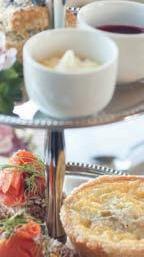
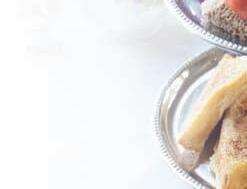

That one word represents an ancient language we all speak.
 TEXT: JILL VAN GYN ILLUSTRATION: LYDIA BEAUREGARD
PHOTO: REBECCA WELLMAN
TEXT: JILL VAN GYN ILLUSTRATION: LYDIA BEAUREGARD
PHOTO: REBECCA WELLMAN
DID YOU KNOW THAT AT ONE POINT VIRTUALLY ALL FOOD WAS PIE?
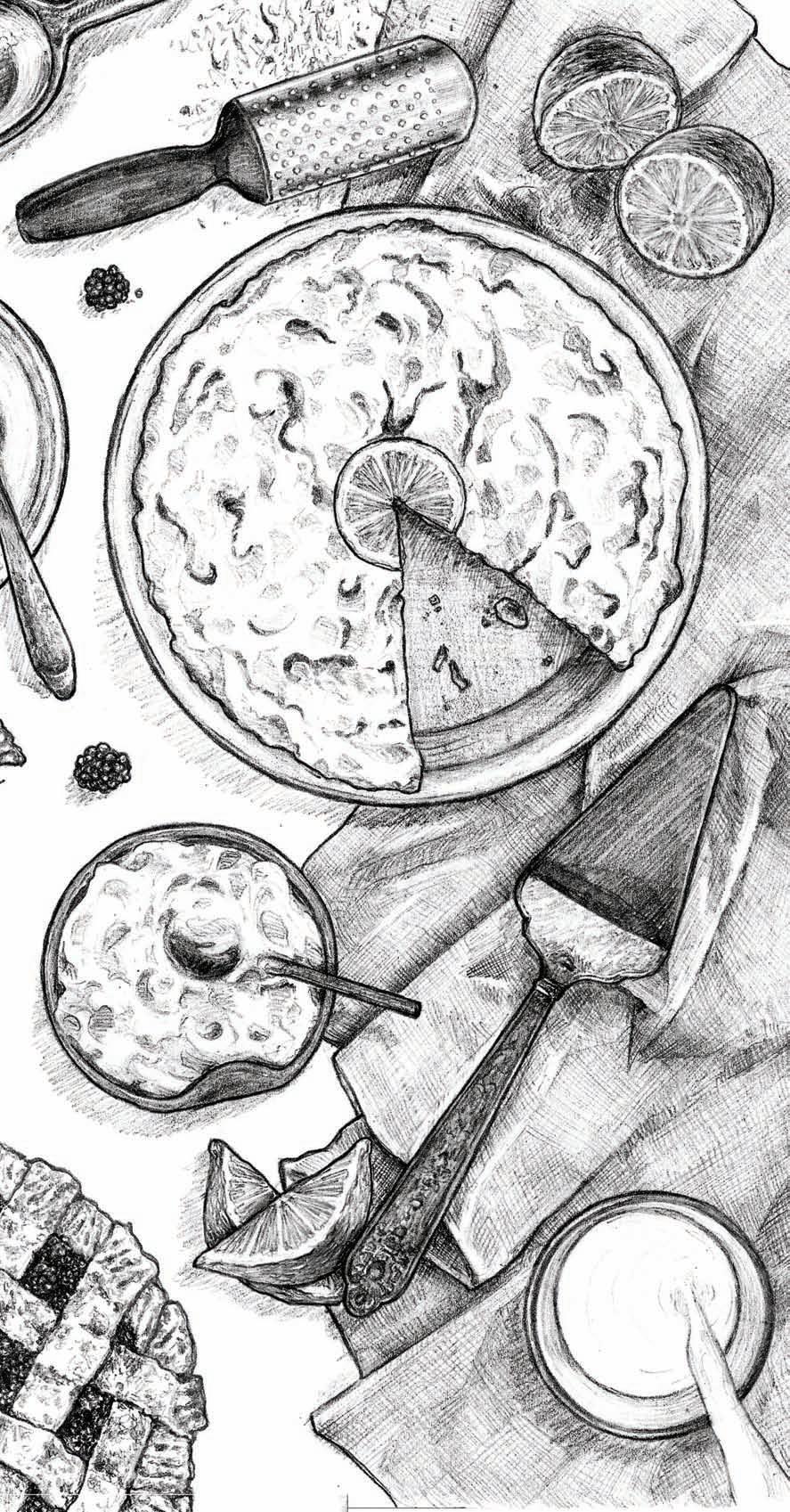
It’s true! For hundreds of years, pastry shells were used as edible storage containers or serving dishes—the original Tupperware if you will. Pie actually has a very traceable history (not one I am going to recount here) that begins way back in 6000 BC in ancient Egypt where rye, wheat or oat galettes were baked over open coals. The practice spread throughout Europe via the Roman roads, every country adapting it to their local cultural food customs. This is what makes pie so great—it is universal. It’s a language we all speak, and we all have that one person in our history, alive or not, that made a legendary pie.
Of all the pastries, pie has the most heritage, tradition and lore attached to it. Pie recipes get passed down from generation to generation. Techniques are whispered from mother to daughter, neighbour to neighbour, and between old friends like a secret that should be sealed by blood oath. Families fiercely guard their recipes and contend that Great Aunt Soand-So’s pie could bring the Queen herself to her knees. Pie recipes hold stories and they hold family histories. My own grandmother was a legend, a pie maven, a pastry wizard. Her pies were unrivalled, and to this day when I bake a pie, the conversation will inevitably turn back to Grandma’s pies. In her old age, though, she stopped being able to measure things out with precision so they got seriously terrible, but no one dared blaspheme her name with such talk – oh no, we still ate them and everyone stuck to the story (until now). We don’t write down our family histories very often, but those pie recipes serve as both an oral and recreated history that ensures our family values are passed down through the ages.
Opinions about pie fats are entrenched. Very few fervent pie makers don’t align themselves with a favoured fat.
Often you will hear, “Oh, but is it a butter crust?” Butter, yes, holds a bit more allure. It’s somehow fancier, the upper crust of pastry fats (if you’re into puns). It’s wonderfully light and flavourful; you can say “well, it’s an all-butter crust” and feel very self-satisfied. However, it’s trickier to work with. It breaks down with even the slightest hint of warmth, which can lead to overhandling, and then you’ve got a tough crust on your hands.
CONTINUED ON THE NEXT PAGE
OF ALL THE PASTRIES, PIE HAS THE MOST HERITAGE, TRADITION AND LORE ATTACHED TO IT.
THIS MOST VERSATILE OF PASTRIES CAN HOLD WHATEVER THE BAKER DESIRES — SAVORY, SWEET, FRUIT, CHEESE OR MEAT.
PICTURED: SUGAR CREAM PIE BAKED BY SUSANNA BRYAN OF RUTH & DEAN BAKED GOODS
 - Laurie Halse Anderson, TheImpossibleKnifeofMemory
- Laurie Halse Anderson, TheImpossibleKnifeofMemory
Shortening is my personal brand of baking. A bit more pedestrian, a dirty little secret, but I do love to announce when asked if it’s butter: “Nope, it’s shortening” as if to say, ‘do not challenge me on this.’ Shortening is easy to work with and delivers every time. I favour it because my grandmother did as well, and after a few years of experience under my belt, I know how to whip it into an easy-to-handle, flaky masterpiece.
LARD
Lard, if I could find a regular source, might have been my ride or die. It’s the true connoisseur’s preference. Lard, real animal lard, is what pastry has been made of for thousands of years. It offers a light, flaky crust, and if you’re trying to keep things “authentic” and organic, lard (read rendered pork fat) is the optimal choice. But good luck finding it! Unless you have a special relationship with your butcher or a good farm connection, getting good lard on the regular is out of the question.
The techniques of pie dough making are as varied as the types of pies on the planet. Every pie maker has a special touch, a trick or a singular method that makes their dough flakier/easier to handle/magic/etcetera. Personalized techniques can be in the recipe, the rolling out or even the filling. For example, are you going to use ice water? vodka? Or maybe you used 7 Up a few times because your mother-in-law insisted it made the best crust. Flour, cornstarch or pectin for the filling? Do you let a filling marinate or do you get it right in there to be as fresh as possible. The answer to all of this is—it depends.
When it comes down to it, rolling out your dough is going to be the most important step in the process, but your dough will not always cooperate. The fun part of committing to pie making is finding out what works for you and your dough. Do you have hot little hands? You might want a glass rolling pin that you can chill. Sticky dough? Be liberal with your flour. Roll it out in small, clockwise movements to avoid your dough looking like a lost continent. My personal technique? I lay out plastic wrap or parchment and roll out between two layers – no sticking, no mess. Techniques are as individual as the pie maker and finding your method is all apart of your pie making journey.
This part of pie making is the most overlooked. We always want to talk crust, never filling! Filling is so important. I constantly focused on crust and ended up with more cornstarch soups than I care to admit. Finding your stride with filling is also part of your life of pie. It’s not just a matter of tossing apples in and hoping for the best. Getting to know your fruit, if that’s what you’re using, is essential. How do blackberries behave in your crust? What about those apples you got gifted by an uncle’s late harvest? Get to know your filling the way you would get to know your crust—this is important advice.

This most versatile of pastries can hold whatever the baker desires—savory, sweet, fruit, cheese or meat. As long as the shell keeps it all (or most of it) in, you will end up with pie. The lovely thing about pie is at the end of the day you might have a tough crust and a soupy filling, but as long as there is fat, flour and sugar involved, it’s going to taste just fine.


The ancient arts of growing, milling and baking grain have been evolving for nearly two decades on Vancouver Island. This is where we are now.

up a handful of speckled spelt flour as it falls from the thick granite stones of the whirring grain mill at Nootka Rose Milling Company.

This is real whole grain flour—nothing added, nothing removed—ground from whole organic grains grown close to home.
It’s the main ingredient in the rustic wheatfree, whole spelt loaves she makes at Wildfire Bakery, bread that contains just three other ingredients, water, natural levain starter and sea salt.
Nootka Rose Milling in Metchosin is a joint venture between Heyrman and baker Byron Fry of Fry’s Red Wheat Bread Bakery . Their stone mill, built by New American Stone Mills in Vermont, supplies freshly milled flour to both city bakeries and to consumers at their small country store.
Sacks around the milling room are bulging with whole grain Red Fife and rye flour, next to the sandy germ and bran sifted from their rustic white flour. It’s fluffy and buff-coloured with a fresh grassy aroma.
“Spelt is a softer ancient wheat with a lovely sweet, nutty flavour,” says Heyrman, rubbing the silky flour across her fingertips.
“We make pastries and cakes with this.”
Nootka Rose is just the latest chapter in a miller’s tale that has been evolving on Vancouver Island for nearly two decades, with the emergence of young bakers sourcing local, organic and heritage grains and milling fresh, stone-ground flour for their breads.
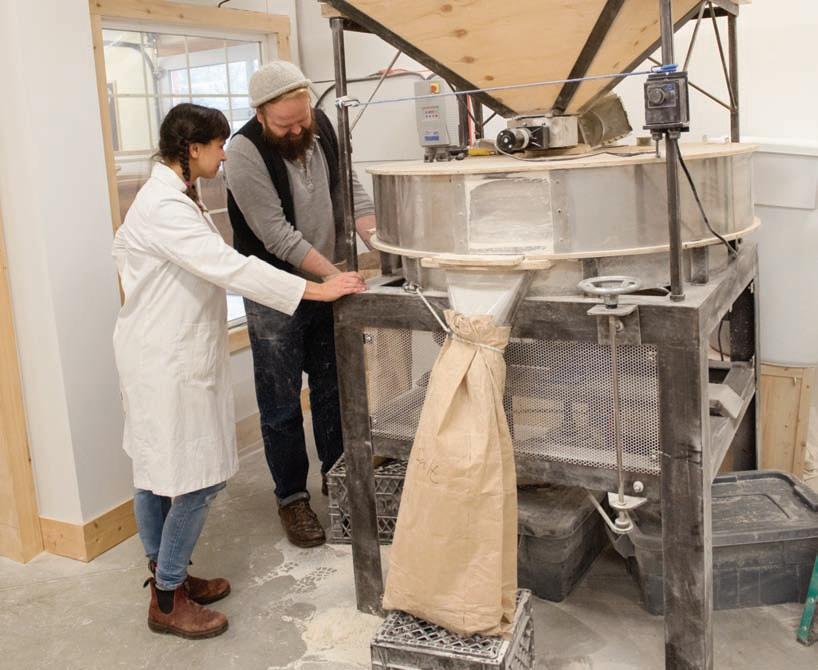
It started with innovative bakers like Heyrman, Cliff Leir of Fol Epi and Jonathan Knight, the original owner of Cowichan Bay’s True Grain (current owners are Bruce Stewart, Leslie Stewart and Todd Laidlaw). Learning old skills—from milling grain to building traditional woodfired ovens and slowly fermenting breads with wild yeasts—became the benchmark for this new breed of craft-driven bakers. When Leir opened his bakery at Dockside Green 2009 he installed two shiny silos to hold the heritage Red Fife wheat and rye grains he uses in his chewy baguettes and whole wheat batards, designing and building a simple but efficient stone mill that has become a prototype for artisan bakers across North America.
Bakers connected with farmers growing organic and ancient grains, from emmer to einkorn, red spring and spelt. Bruce Stewart of True Grain Bread says sourcing
island wheat was an early priority. He found farmers like Metchosin’s Tom Henry and Sloping Hill Farm to supply local grains for their original mill in Cowichan Bay, but has since expanded operations with bakeries Courtenay and Summerland, added a central milling facilitiy, and shifted his focus to organic grain growers in BC. The art of old-fashioned milling was revived and perfected. Today, the rustic loaves produced at True Grain, Fol Epi, Wildfire and Fry’s Red Wheat bakeries are all made with fresh, organic, stone-ground flour, milled daily. These bakers chose to mill for different reasons—to obtain fresh, unadulterated flour for their breads, to support the local economy and food systems, even to reduce their carbon footprint—but all agree that stone-milled flour is a world away from the highly refined white flour typically produced in today’s large, industrial flour mills. It’s healthier and tastier too.
“The bread tastes so good when you use fresh, stone-milled flour,” says baker Byron Fry of Fry’s Red Wheat Bakery. “I was immediately hooked.
“But there are also significant health benefits to consuming fresh, whole grain flour and breads,” he adds, pointing to a McGill University paper outlining the
Bakers connected with farmers growing organic and ancient grains, from emmer to einkorn, red spring and spelt.
detriments of consuming industrial, rapid-rise breads, and the laundry list of additives, chemicals, stabilizers and preservatives routinely added by large commercial flour mills. “People who come here are raising their kids on my bread and that’s important.”
Erika Heyrman was a pioneer of the artisan bread business and has been milling organic grain for her breads for nearly 20 years. “All of our grain is organic, and all is from B.C. growers,” says Heyrman. “We grind all of our own whole grain flours at Wildfire. It reflects my values, to be socially responsible and community oriented.”
True Grain’s current owner, Bruce Stewart, now has bakeries in Cowichan Bay, Courtenay and Summerland, with a central stone milling facility to produce fresh, organic, B.C.-grown flour.

“I did a greenhouse gas audit about five years ago—it was quickly evident that the biggest impact I could have was inbound freight of grain (from Saskatchewan),” says Stewart. “From then on, I went on a mission to connect with B.C. farmers—every speck of flour in True Grain bread - or pastry or cookie - comes from a B.C. farm.”
But Stewart is also concerned about the additives required and allowed in most of the flour produced in Canada. Ten large companies mill more than 3.5 million tonnes of wheat, oats and barley in Canada each year and, according to Division 13 of the Canadian Food and Drug Regulations, white flour “shall be free of bran and germ,” must be enriched with minerals stripped out in the milling process, and may contain a long list of chemical additives from amylase to l-cysteine.
“Most of the additives fill the role of making it look better and more appetizing, or making is perform consistently, or better by enhancing gluten development and baking properties,” says Stewart, noting none require labelling on bags of commercial flour.
In commercial whole wheat flour, some of the bran is added back into the flour but none of the germ, the main source of nutrients in wheat. Ironically, that’s the product mills sell elsewhere, for use in animal feeds and supplements.
As a child of the Canadian prairies, I never thought too much about where my flour was coming from. It seemed a given that The Grain Belt, The Bread Basket or however you describe that wide swath of flat farmland bisecting the country, was simply the source of the best wheat in the world.
But then I met Stephen Jones, director of The Bread Lab at Washington State University and a bit of a grain god in the world of artisan baking. He is an expert wheat breeder, an academic, a farmer, baker and promoter of the idea that flour, like any other food, can literally be a reflection of its local roots.
“We’re exploring the issue of terroir and bread,” says Jones, pointing to a patchwork field of small test plots at his Mount Vernon campus, where more than 3,000 different wheat varietals are grown, harvested and milled by grain graduate students. The lab acts as a hub for bakers, chefs, farmers and anyone else interested in working outside the industrial milling and baking model to create better bread.
“We’re breeding new wheat with flavour, functionality and nutritional density in mind,” says Jones of the program that literally takes grain from the field to the fork. “All of my students work in the lab and they all bake—I require that.”
This is grain designed for cultivation outside the current commodity system, for bakers and pasta makers who want to work with flour that’s ground using old-fashioned stone mills to preserve each grain’s unique qualities. “White flour and high yield are commodity wheat targets, but we deal with variation,” he explains. “We’ll develop a blue waxy wheat or a Red Russian for pasta. We also work with barley for brewing and buckwheat for soba.” Staple crops, including grains and legumes, can be part of
sustainable regional food systems and economies, he says. Jones is also on a mission to educate consumers about freshly milled whole grains, and what should, and should not, be found in your daily bread. Today, 30 percent of consumers report they have cut bread and gluten from their diets, due to real or perceived problems with digesting wheat. Modern, hybridized wheat is often blamed for this epidemic of gluten intolerance, but pinpointing the problem is complicated. Whether it’s the wheat itself, the common practice of spraying grain crops with glyphosate (Roundup) as a desiccant before harvest, the various chemicals added to refined flour or even the high-speed process of baking commercial bread, there’s little conclusive research.
Steve Jones doesn’t blame the wheat, but rather the modern industrial milling and baking systems behind the loaves most people consume today.
Most breads contain additives such as vital gluten, yeast, sugars and preservatives, he says, and rely on industrial baking protocols, from lots of yeast to quick rises and bakes that take minutes rather than days. The white and whole wheat flour produced in major mills (and sold in
supermarkets) is highly processed, treated with additives, preservatives, vitamins and maturing and dough conditioning agents.
“It’s very tough to find a good plastic-wrap bread,” he says, referring to the vast majority of bread products consumed in the industrialized world today.

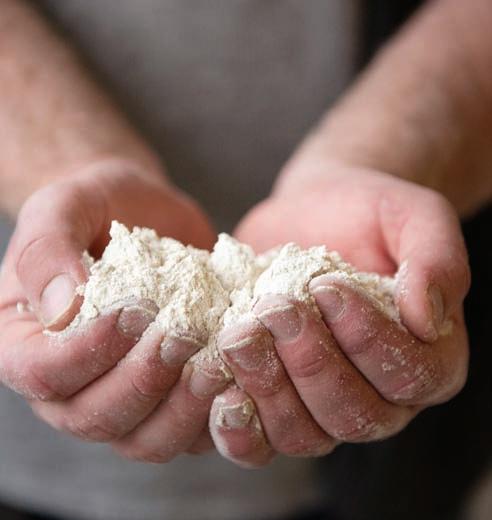
By contrast, unadulterated, stone-milled flour and traditional slow, wild ferments create breads that are easier to digest, with more bioavailable nutrients and a lower glycemic index. And at the cost of a specialty coffee, a healthy handcrafted loaf is an incredible bargain.
At the university’s annual Grain Gathering (2018 will be its eighth), more than 250 artisan bakers, farmers and millers from across North America congregate. It’s literally ground zero for grain geeks, a place for artisan bread and pasta pioneers to share experiences and exchange information about grains, flour, fermentation and milling.

“Every year we come together to talk about bread, politics and local grain economies,” says Jones of the event that attracts
A HANDFUL OF WHOLE
people from “five provinces, eight countries and 24 states. It’s just a little wheat field in Washington but it turns into a happening,” says Jones.
Victoria’s Leir was one of the artisan bakers invited to speak at the first gathering in Washington, sharing his baking and milling expertise and helping other bakers assemble mills and “dress” their millstones. Byron Fry and other B.C. bakers have also attended the event.
“We call them our cool Canadian contingent,” says Jones.
Grain may be the final frontier when it comes to the locavore movement. And as we continue the quest for transparency and connection to our food sources, the commodity crops that literally supply “our daily bread” are under new scrutiny. For Shira McDermott and Janna Bishop of Vancouver’s GRAIN , tracing prairie grain and seed crops from farm to table and connecting consumers with growers is the priority. The goal is to put a face on prairie farmers and celebrate their Canadian crops.
“We source directly from Canadian farmers and sell only premium export quality,” says McDermott of the whole grains (einkorn, emmer, spelt, Red Fife and Lilian wheat), Laird green lentils, black lentils and chickpeas you’ll find in their distinctive brown paper boxes and bags. Their Red Fife and organic durum wheat flours are freshly stone-ground to order, and their legumes are labelled with caricatures (and bios) of the farmers who produced them. “We work closely with these farms, and we ship our products across Canada,” she says. Though most of the farms are growing conventionally, McDermott says buying directly insures top grade grains and dried legumes
“Our basic necessities are bought and sold on markets like oil and gas,” she says, “but consumers deserve fresher flour and better quality dry goods.”
Victoria’s artisan bakers also sell their freshly milled flour to home bakers and chefs. Fol Epi offers bags of whole grain or sifted Red Fife and rye flours for $4 and $5 a kg at its bakeries. Nootka Rose Milling sells bags of organic whole grains, legumes




and stone-ground flour at their retail store, stone-ground organic flours are available from True Grain, and you can order flour, milled-to-order online from GRAIN.
Stone-milling flour, literally grinding the whole kernels of grain between two heavy granite stones, is the equivalent of “cold pressing” olive oil. Flour is produced slowly and at low temperatures, with all of the oils, germ, bran and nutrients intact. Though loaded with flavour, the downside to fresh, stone-ground flour is its limited shelf life. The oils in whole-grain flour will oxidize quickly and turn the flour rancid, so it must be used within weeks, or frozen for longer storage.
You’ll also find organic and ancient B.C. grains in other local products, whether it’s pasta, beer or whisky.



At Cowichan Pasta , Matt Horn uses semolina from ancient grains, including B.C.-grown organic khorasan, emmer and spelt, milled by True Grain. The semolina necessary for pasta is a lucky byproduct of the bakery’s sifted flours and makes nutty, whole-grain pasta that’s easier to digest.
“It’s a very niche product and more expensive to make, but our customers have no issues with it,” says Horn. Island brewers have also helped raise the profile of local and ancient grains. Philips Brewing sources barley “grown 15 minutes away” and is the only craft brewer in the country malting barley on site. The award-winning Glen Saanich and Ancient Grains whiskies from deVine Vineyards in Saanich utilize barley grown on Vancouver Island and organic khorasan, emmer and einkorn from Okanagan growers.
The artisan bread baking world is small and there’s no doubt Victorians are spoiled for choice when it comes to healthy, wholegrain bread. Heritage, ancient and organic grain growers are uncommon in Canada, and bakers who mill their own flour are a very rare breed.
Most of the country’s operational stone mills are museum pieces, pretty riverside relics like the historic mill grinding heritage grain in Delta, Ontario (a national historic site), the La Seigneurie des
thank you for your patience while we upgrade our systems upgr or ythfankyou tems de sys a ience whil at our por y e
Aulnaies stone mill, artisanal bakery and museum in Quebec or The Grist Mill in Keremeos, B.C., where famed Red Fife wheat was first revived.
But the appetite for good bread is on the rise, and chefs, consumers and home bakers are all looking for flour with better nutrition and taste.
At The Night Oven in Saskatoon, Bryn Rawlyk turned to Cliff Leir of Fol Epi for advice on building his oven and milling local grain. Little Stream Bakery in Perth, Ontario, mills spelt, kamut and rye for its breads, and True Grain has expanded with bakeries in Courtenay and Summerland.
“I think increasingly people are buying based on their values,” says Stewart of the growing demand for better bread. “There is a degree of trust with us, from the field all the way through to the bake. It is bigger than the organics and stone milling, it’s about the craftsmanship of making proper bread.”
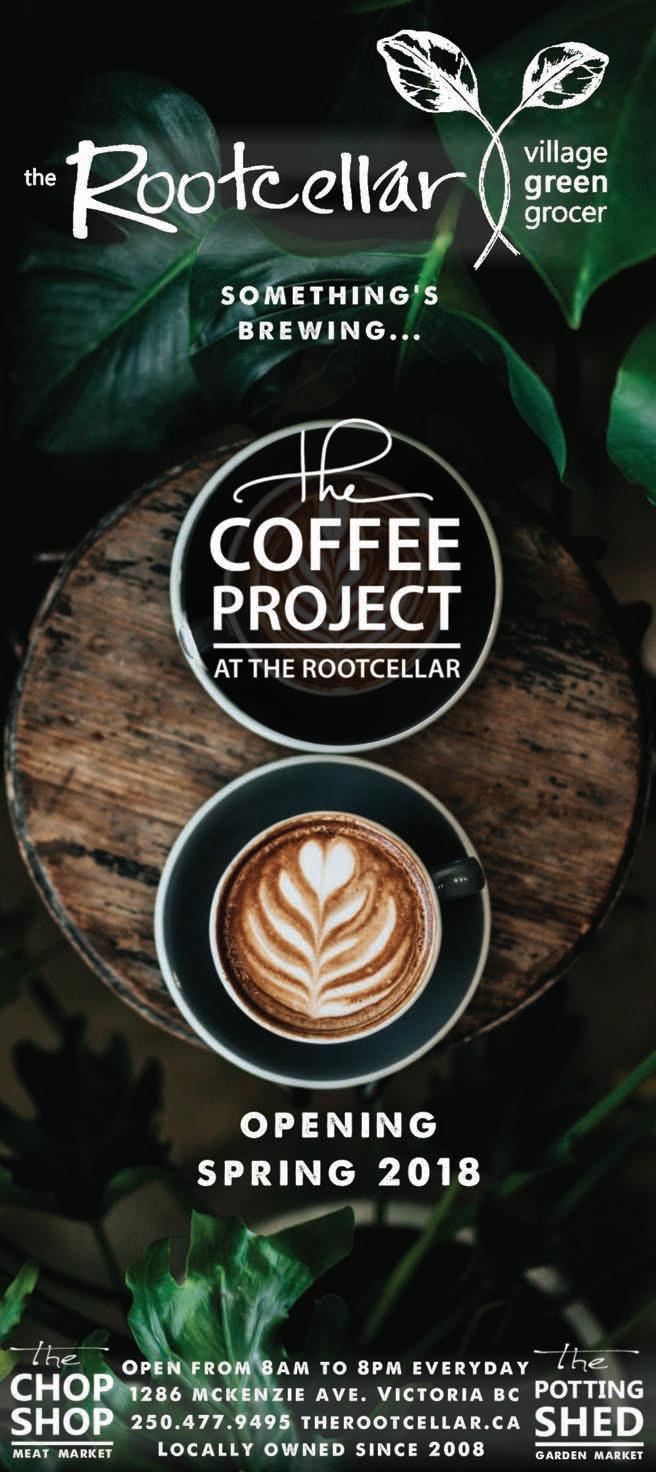
It’s no wonder our daily bread here in Victoria is some of the finest in the land.
Looking for true artisan loaves that express the flavour, texture and terroir of organic, heritage and ancient grains? Here’s a taste:
FOL EPI WHOLE WHEAT
This is a dark, chewy loaf that gets its robust character and flavour from stone-milled Red Fife flour (both whole grain and sifted), rye flour, and a slow, wild yeast fermentation.
FRY’S WHOLE WHEAT COUNTRY
Made with organic Red Fife and a small percentage of organic rye flour, this is Fry’s classic German-style loaf, with strong rye flavour developed through the fermentation of freshly milled flour.
PORTOFINO VANCOUVER ISLAND WHOLE GRAIN
This loaf is one of two Portofino makes using Metchosin-grown wheat that’s milled at the bakery in Victoria, and a two-day baking process to develop additional flavour.
Organic ancient grains are stone-milled at three True Grain bakeries (including the original in Cowichan Bay) to create these wholegrain (emmer, spelt or khorasan) artisan breads they’ve labelled “the healthiest loaves money can buy.”
This naturally leavened (levain) bread gets its flavour, chewy texture and crust from the slow rise and the stone-ground organic wheat flours—locally grown wheat from Metchosin combines with certified organic B.C. wheat and rye.
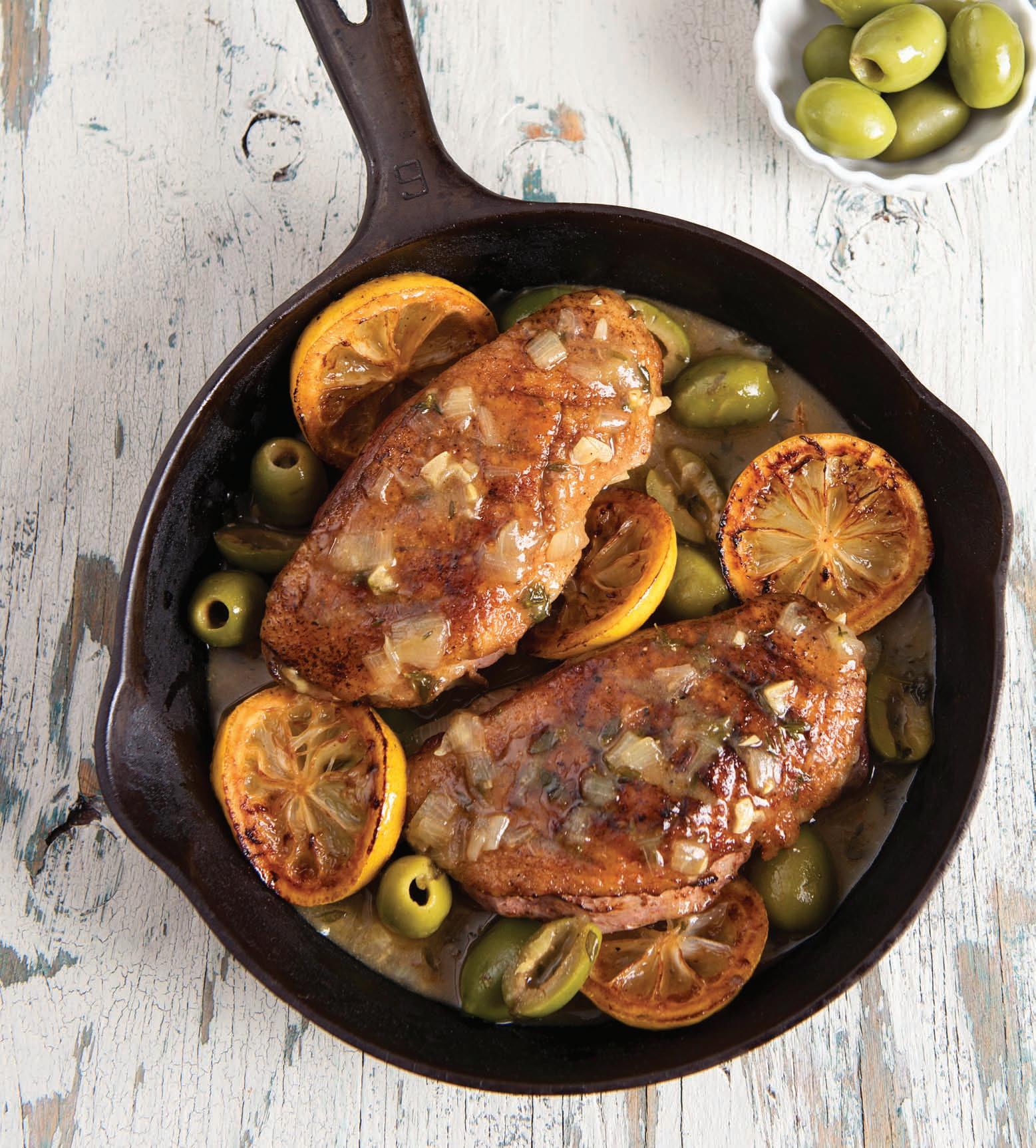
Don’t be daunted by these decadent dishes, duck is not difficult to prepare and should be easy enough to find in your local grocery, or just ask your butcher. And pairing with a beautiful homemade gnocchi is sure to be a hit with friends and family… you don’t have to tell them how simple it actually is!

Gnocchi is easy enough to make at home, you do have to pay attention to a few key points in the process to achieve the right texture. The culprit in tough gnocchi is usually one of two things (or both): too much flour in the dough or too much kneading.
2 large russet potatoes, scrubbed clean, about 675 g ½ tsp salt
Zest from 1 washed organic lemon
2 egg yolk
1 cup flour
Pre-heat the oven to 350°F (180°C).
Prick the potatoes with a fork and place directly on the oven rack. Bake for 1 hour or until tender.
Remove the potatoes from the oven, peel while still hot and press through a potato ricer. Place the potato purée on a lightly floured surface and sprinkle with the salt. Let it cool.
Incorporate the zest and the egg yolk.
Sprinkle gradually the flour into the potatoes while gently using your hands to combine the ingredients. If the dough is too sticky, add flour.
On a lightly floured surface, roll 4 pieces into a long 1-inch thick rope. With a knife, cut each rope into ½-inch gnocchi. If you like, you can give your gnocchi grooves. Shape the pieces into balls and roll them down a gnocchi board or fork. Set aside on a lightly floured baking sheet.
Into a large pot of salted simmering water, gently drop one-third of the gnocchi at a time. Once they float to the surface, let simmer for 2 minutes. For best results, remove the gnocchi from the water with a slotted spoon.
Add a kale and pea sprout salad, some red wine and crusty loaf and you have the all you need for a terrific weekend dinner party.
For centuries duck meat has been a great part of French gastronomy, known to have excellent nutritional qualities, low in calories, it is suitable for any occasion. There are many people, however, that have never tried it or they simply never use it in home cooking.
Duck is a great source of protein, B-vitamins, iron and essential minerals. When cooked correctly, it is juicy and tender, and the duck fat (while lower in polyunsaturated fats) is oh-so-tasty!
2 – 325g boneless duck breast
Salt and ground pepper
½ lemon sliced
1 tbsp butter
2 large shallots, sliced large 250 g mushrooms, your choice
3 garlic cloves, chopped
2 tbsp fresh thyme leaves
1 cup olives, pitted
2 cups white wine or poultry broth
1 tbsp flour
Remove a thin layer of fat from the breasts. Using a sharp knife, score the remaining fat diagonally without cutting into the meat, season generously.
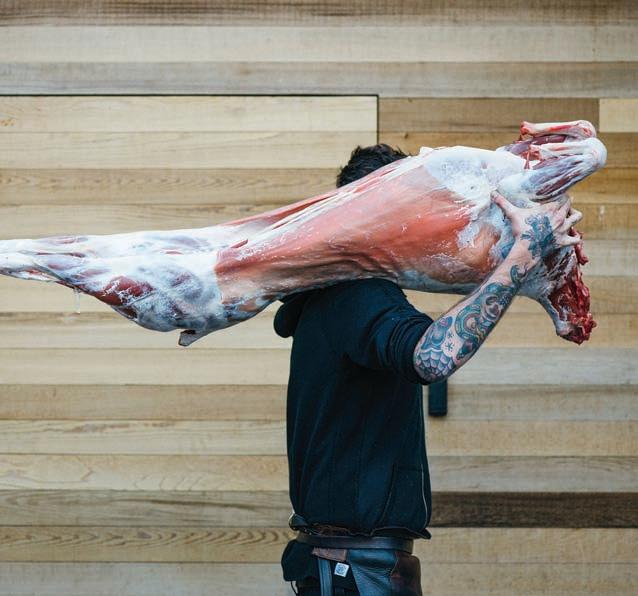
Pre-heat oven to 190°C (375°F).
Place the duck skin side down in a large heavy based pan. Cook for about 10 minutes over medium-low heat. Once the fat is golden and crispy, turn the breasts and cook 2 more minutes to seal.
Transfer breasts on a sheet pan and cook in the oven for 8 to 10 minutes or until it reaches an internal temperature of 58°C (137°F). The breast should be medium firm to the touch and still pink inside.
Once the duck is cooked, let it rest for 5 minutes on a plate, covered with a piece of aluminium foil.
Spoon off any excess duck fat* from the pan. Add the lemon slices and cook on medium high until slices are caramelized. About 2 minutes. Remove the lemon slices and reserve.
On medium-low heat, melt the butter in the same pan and cook the shallots and mushrooms for 4 minutes. Add the garlic, the thyme and the olives and cook for 1-2 more minutes. Sprinkle with flour, mix and pour the wine, let it reduce by half.
When ready to serve, slice the duck breast on the bias and serve accompanied with the gnocchi, the sauce and garnish with lemon slices and fresh thyme.
*Duck fat can be saved in a sealed jar in the fridge for later, delicious on roast potatoes!
Look for a syrah from British Columbia such as the Laughing Stock Syrah 2015 or a a rich and chewy, herbal Provençal red from France.

Salads can be far more versatile than their usual role as an opening act. Turn the page for big ideas for big salads.
 By Shelora Sheldan,
By Shelora Sheldan,




VEGETARIANS
, served hot or cold or somewhere in between, salad can move from lunch to dinner to tapas to a midnight snack with ease.


And winter’s chill doesn’t mean the salad course should be swept by the wayside—far from it. With a few tips and techniques, salad can provide cold weather comfort until spring’s verdant shoots and produce are once again mainstays.

Before spring greens appear, I turn to seasonal curly endive, or frisée, and sturdy escarole, a broad-leaved endive for my salad. They pack more flavour and texture, stand up to dressings either delicate or bold, and are a welcome change from those ready-to-eat cello packs of enfeebled organic greens. Sturdier yet are nutrient-rich collard greens. Just remove their tough centre stems (save those for soup) and roll the leaves together like a cigar to julienne for thin shreds. An aggressive dressing is key here, whether it’s creamy or just boldly spiked with ginger and garlic. The same goes for the many varieties of kale. Lacinato and the succulent winter red are two of my favourites. Then there’s the underrated iceberg lettuce with its juicy crunch. I love serving it as a wedge on a plate drizzled with blue cheese dressing and devoured using a knife and fork. For boxed and pre-washed greens, I will give a shout out to arugula, whose peppery notes add zing whenever needed. The same praise goes for baby leafed spinach. With all the greens I’ve listed, try using all of them in tandem for a nutrientrich exploration of flavour and texture.
Letting go of the notion that lettuce defines salad opens the door to true culinary adventure. Incorporating a new-to-you herb, vegetable or recipe opens up your mind and your palette.
For example, in Southeast Asia unripe papaya is used as a salad base, julienned with an abundance of cilantro and lime juice as bright and acidic protagonists. In the Mediterranean, panzanella consists of humble leftover bread soaked in olive oil and garlic tossed with a boatload of basil and tomatoes. And further east, dried pita bread becomes fattoush, alive with sumac and vegetables. And don’t save garlicky croutons just for Caesars; they add texture to any salad.
Fresh organic herbs, available all year round, add delicious interest at every turn. Chopped dill, flat-leafed parsley, mint and cilantro are just some of the herbaceous wonders you can add together or separately to a bowl of greens, or use as greens themselves. For further inspiration when using herbs, I recommend the veggie-focused cookbooks of Yotam Ottolenghi, in particular, Plenty and Plenty More. I know of no other author and cook who can conjure up such astonishing and delicious salads with such creative abandon while drawing from so many culinary heritages.
The world of grains and pulses provide a wealth of options for salads, and fresh herbs can receive star billing instead of bit parts. Traditional tabbouleh, for example, is more
FROM SOMETHING EATEN AS A PREAMBLE TO THE MAIN COURSE TO BECOMING THE MAIN COURSE ITSELF, SALAD IS EVOLVING.
about the parsley than the bulgar wheat. Add in some chopped mint and you have an herbaceous flavour explosion with minimal hits of bulgar for texture. Quinoa is familiar to most, but millet can be used interchangeably. And a light toasting in a dry skillet before cooking adds another dimension. With a flavour comparable to toasted cashews, millet is wonderful served warm tossed with olive oil, lemon juice and a coterie of vegetables. Barley and wheat berries are incredible as a hearty salad base and pair well with whatever you throw at them—chopped mint, dill and parsley with pomegranate molasses for tart sweetness, or feta, sundried tomatoes and preserved lemons, or roasted squash and chickpeas with a honey and poppy seed dressing. Served on a platter, these are great dishes for the potluck set or a buffet gathering. There’s a storehouse of grains out there to try, but I heartily recommend looking out for the sustainable, farm-direct products from Vancouver’s Grain. Started by Shira McDermott and Janna Bishop, they source quality grains and pulses direct from Canadian farmers. Their website is packed with delicious recipes and information. Singular ingredients are also fun to play around with. Take an economical Japanese mandoline to three or four sticks of celery and fill a bowl with thin slices. Their natural juices meld well with just a drizzle of quality olive oil and sprinkling of sea salt, making a refreshingly crunchy amuse-bouche. And carrots, grated on the fine side of a box grater, are exquisite tossed in a mustardy vinaigrette and sprinkled with chopped parsley for colour.

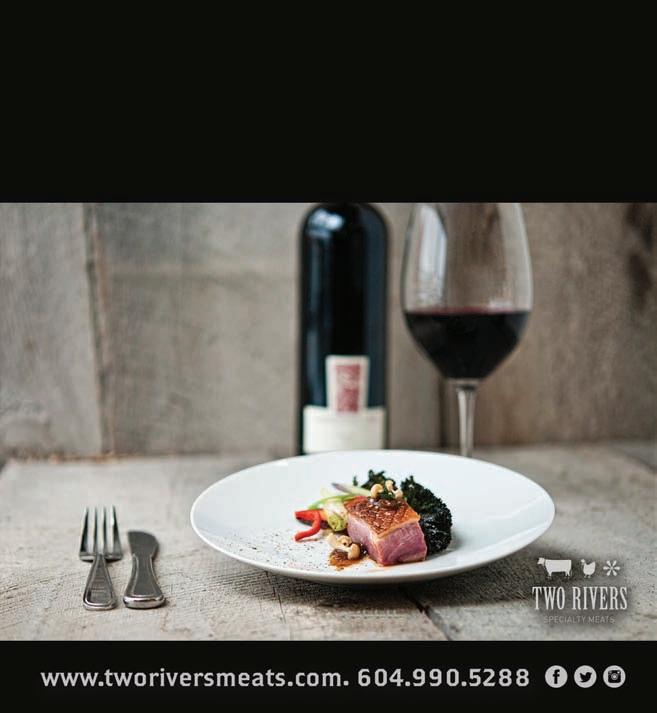
From hazelnuts to sesame seeds, think about adding toasted nuts and seeds to the list, as well as roasted or grilled vegetables. Roasted onions, beets and squash, stored from autumn’s harvest, are all great additions. Roasting cauliflower or Brussels sprouts until they caramelize adds more depth, as does charring. Exploring textures is also gaining traction with today’s modern chefs. At Olo, a dish of turnips will be presented in a trio of raw, roasted and fermented.
A warm dressing brings another guise to the salad course, where meat can play too. Olive oil, lime juice and an abundance of garlic with maybe a chipotle en adobo add range tossed with grilled skirt steak and frisée lettuce. Just add tomatoes and avocado for something muy Mexicano. Another warm dressing I like is bacon fat with freshly chopped mint, red wine vinegar and shallots. Serve with spinach leaves for a new take on the standard spinach salad with bacon and hard-boiled egg.
Sundried tomatoes and preserved or grilled lemons added to vinaigrettes, as well as Middle Eastern spices like harissa and sumac and olives and cheeses in all their permutations provide plentiful options for adding depth to salads. Look to various vinegars and citrus juices, even pickle brine, to change up the dressing table, or thick yogurt and homemade mayonnaise for creamier options.


We can bid a fond adieu to the brassicas now that spring has sprung and with it edible wild greens. Miner’s lettuce, unsprayed dandelion leaves, ox-eye daisy and nettles are but a few to be harvested in our region. Wild foraging expert and chef Bill Jones of Deerholme Farm offers identification and cooking classes in March and April to help you discover these wonderful delicate greens.
Saanich’s Sunwing Farms is once again open for the season offering crunchy baby cucumbers, herbs and tomatoes. And California produce at the Root Cellar comes on strong (it might not be seasonal here but it is somewhat regional) with new crop asparagus, fava beans, fennel bulbs and artichokes, to name a few. Locally, first-of-theseason rhubarb, green garlic and baby greens give us hope for the coming growing season.
In whatever guise or combination, I hope you’re inspired to eat your greens.
Roasted nuts, cranberries and sunflower seeds for topping the curry
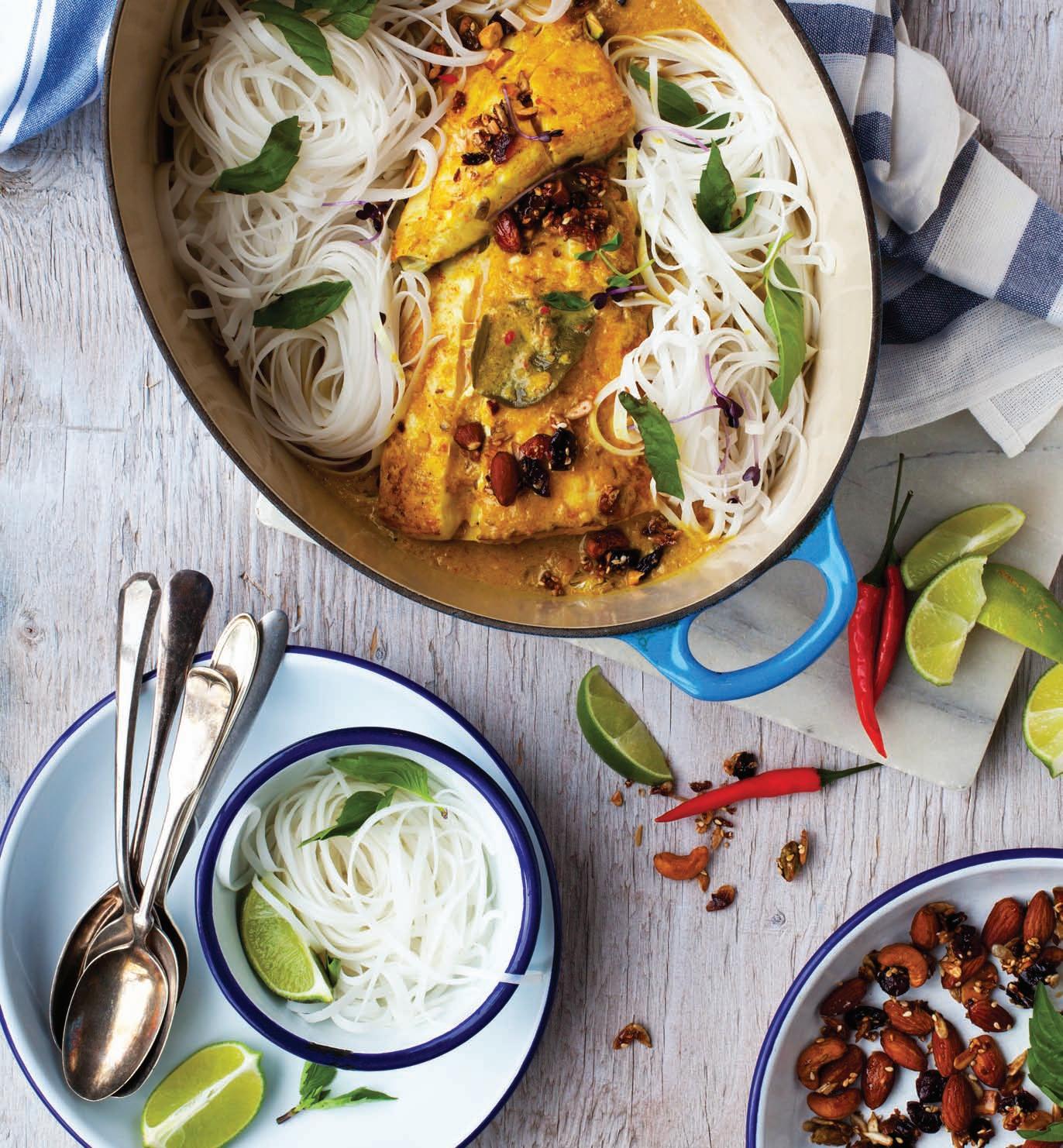
These early days of spring can still call out for big, rich flavours. a bold, bright curry and a sumptuous chocolate-caramel treat keep the chills away and the spirits elevated until sunnier days arrive.

Serves 8.
1 onion, coarsely chopped
1 large stalk lemongrass (trim top and discard outer leaves), chopped
5 garlic cloves, smashed
2 Tbsp finely grated fresh ginger
1 Tbsp finely grated fresh turmeric
⅓ cup vegetable oil
1 Tbsp cumin seeds
2 tomatoes, coarsely chopped
3 Tbsp palm sugar or honey
2 Tbsp fish sauce
1 Tbsp garam masala
1-2 bird’s eye red chilies (not seeded), chopped*
1 tsp sea salt
4 kaffir lime leaves
2 400-mL cans coconut milk
2 16-oz halibut fillets
Salt and pepper, to taste
1 Tbsp oil
1 cup coarsely chopped cilantro or basil
In a food processor, pulse together onion, lemongrass, garlic, ginger and turmeric until almost puréed.
In Dutch oven, heat oil over medium heat until hot (be patient); add cumin seeds and sizzle for 1 min. Scrape in onion mixture; cook, stirring often, for 15 min. Stir continuously towards end of cooking to prevent sticking.
Meanwhile, purée tomatoes with sugar, fish sauce, garam masala, chilies* and salt. Stir into onion mixture along with lime leaves. Sauté, stirring occasionally for 5 min., then add coconut milk. Bring to a boil; reduce and simmer until sauce thickens slightly, 5 to 8 min.
Meanwhile, season halibut with salt and pepper. In a skillet, heat oil to medium-high; add fish skin-side up. Sear until golden, 3 to 4 min.; transfer to Dutch oven. Cover and simmer until fish is cooked through, 8 to 10 more min. Sprinkle with basil; serve with rice noodles and lime wedges.
Prep sauce only. Cool and refrigerate up to 5 days; this will allow flavours to blend. Rewarm sauce; sear fish, then simmer in sauce before serving. * I find that fresh chilies sometimes don’t pack the heat I expect. Blend in one, then taste and add another if needed.
1715GovernmentStreet
250.475.6260
www.lecole.ca


eat@lecole.ca
Dinner5:30-11pm


TuesdaytoSaturday
On a parchment-paper-lined baking sheet, combine ½ cup each almonds, cashews, pistachios and pecans with ¼ cup each cranberries and sunflower seeds, 1 sliced Thai red chili, 1 Tbsp sesame seeds and 1 tsp each coriander seeds, mustard seeds and salt. Drizzle with 3 Tbsp honey and 1 Tbsp oil; toss to evenly coat. Roast in preheated 350°F oven, stirring occasionally, until browned, about 20 minutes. Chop; sprinkle over curry.
For The Crust
1 cup unsalted butter, softened

⅓ cup each granulated sugar and packed light brown sugar
1 egg yolk
1 tsp vanilla extract
2¼ cups all-purpose flour

½ tsp smoked or regular sea salt
For The Caramel
2 14-oz cans sweetened condensed milk
1 cup unsalted butter, cut into cubes
1 cup packed light brown sugar
⅓ cup light corn syrup
1 tsp vanilla extract
Pinch sea salt

For The Topping
300 g dark chocolate, finely chopped (Tip: try chocolate infused with chilies)
½ cup whipping cream
Smoked or regular sea salt, for garnish
To Make The Crust: Line a 9-by-13-inch baking pan with parchment paper. Place butter in bowl of standing mixer; beat until light and fluffy. Beat in sugars, scraping down side occasionally, until well creamed. Beat in egg yolk and vanilla. Gradually beat in flour and salt, just until mixed, scraping down side of bowl as needed. Dough should be a little crumbly; evenly press into prepared pan. Bake in preheated 350°F oven until edges are light golden, about 25 minutes. Remove from oven and let cool while preparing the caramel.
To Make The Caramel: In a large wide saucepan set over medium heat, stir together condensed milk, butter, sugar and corn syrup until butter is completely melted. Continue stirring until mixture comes to a boil (but don’t increase heat); simmer and stir frequently until mixture thickens and turns deep butterscotch, about 15 more minutes. Remove from heat; stir in vanilla and salt. Pour over crust, tilting pan to evenly fill. Let stand at room temperature until cool, then refrigerate until well chilled.
To Make The Topping: Place chocolate in a small bowl. Heat cream to a boil; pour over chocolate. Let stand 1 minute; whisk until chocolate is melted and evenly mixed. Spread over cooled caramel layer; sprinkle with salt. Refrigerate until set. Cut into small squares (they’re rich!).
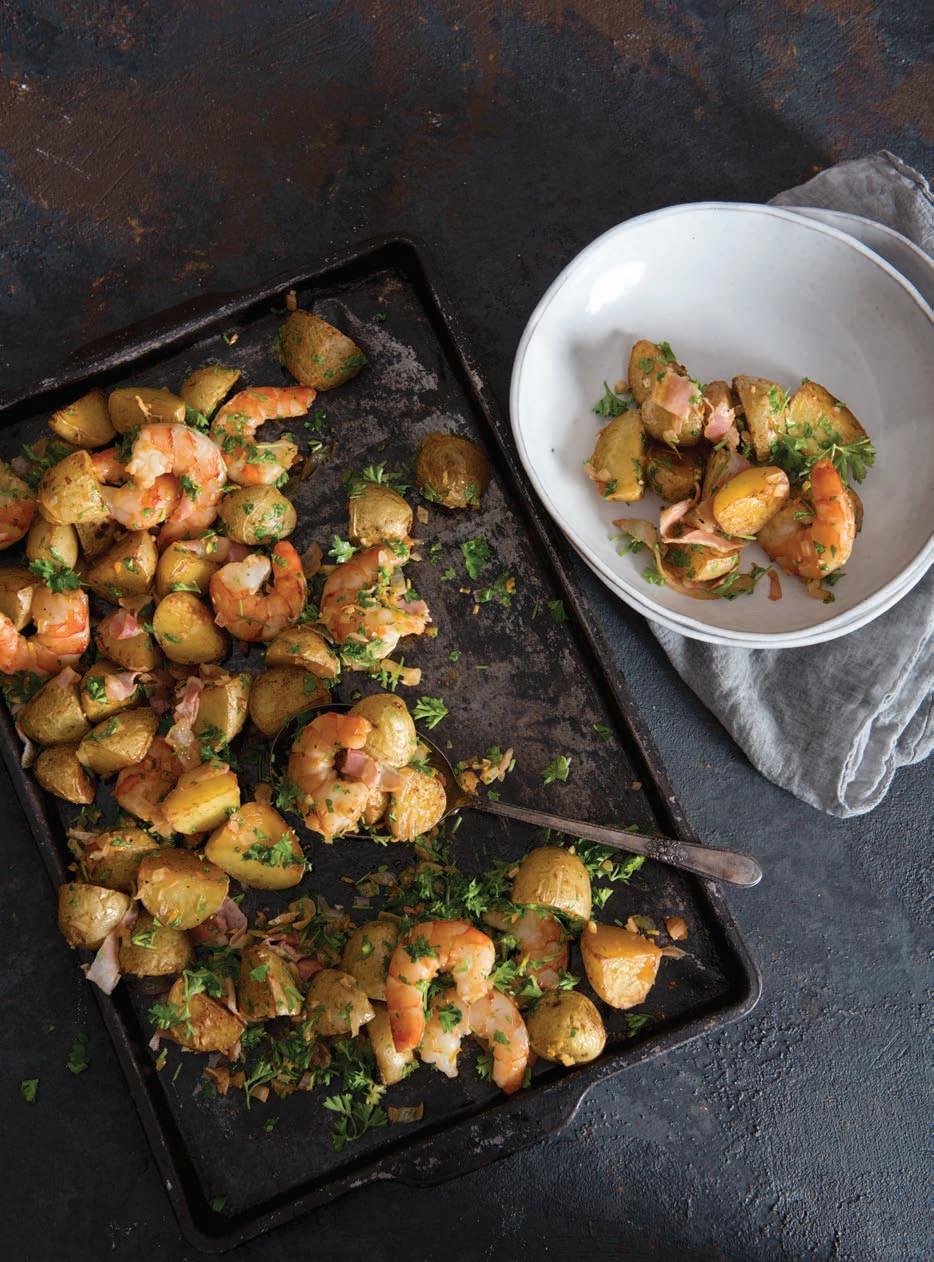
Prawns and pancetta are paired with lemon and paprika to give this salty-tangy meal its edge
When spring comes, I open all the windows and doors, clearing away the cobwebs of winter’s hibernation to make way for new growth, bright sun and fresh air. The longer days offer more time for the outdoors and less time for long-simmering stews and complicated recipes. Who has time for highmaintenance cooking? Let’s make it quick and easy, but never lacking in flavour. I like layers of citrus, something green and maybe a touch of spice. I used tiger prawns, but you can substitute cooked chicken or sausage—or leave them out entirely. I like the subtlety of pancetta, but feel free to replace with prosciutto or cooked bacon. Make this your own: sweet potatoes instead of Yukon golds, red onion instead of shallot, arugula instead of parsley. As with all new beginnings, the possibilities are endless.
1 large shallot, diced
2 large garlic cloves, minced
2 Tbsp fresh lemon juice
2 tsp smoked paprika
3 Tbsp plus 1 tsp olive oil
4 lbs Yukon Gold potatoes, cut into 2-inch pieces 200 g thin-cut pancetta, chopped into slices
Zest of one large lemon
Zest of one large orange
2 lbs raw tiger prawns, peeled, deveined and pat dry ½ cup minced curly parsley
Hot sauce or chili oil to serve (optional)
Preheat oven to 380°F.
Place shallot, garlic and lemon juice in a small bowl. Set aside.
In a large bowl, whisk together paprika and 3 Tbsp olive oil. Add potatoes and toss to coat well. Season with salt and pepper. Spread out on a large rimmed baking sheet and roast for about 15 min., or until potatoes are just fork-tender.
Add pancetta and shallot mixture to the potatoes and stir with a spatula to distribute evenly. Return to oven and roast for another 5 min.
Toss the prawns in 1 tsp olive oil. Add lemon zest, orange zest and prawns to the potatoes and toss to combine. Return to oven and roast for another 5-7 min., until prawns are just pink.
Remove from oven and stir in the parsley. Season with salt and pepper and serve with hot sauce or chili oil.
The true love story between Québec and poutine starting sometime in the 1950s as a gooey concoction of French fries, cheese curds and gravy more apt to turn up at chip wagons and hockey arena snack windows than white tablecloth restaurants. That all changed in 2001 when Martin Picard, a Québécois chef, made his poutine with foie gras the signature dish at his now-acclaimed Montreal restaurant Au Pied de Cochon.
15 mL (1 Tbsp) butter
1 shallot, chopped
2 garlic cloves, minced
15 mL (1 Tbsp) brown sugar
15 mL (1 Tbsp) cider vinegar
500 mL (2 cups) veal stock
60 mL (1/4 cup) red ale (there are numerous examples from BC)
1 bay leaf
30 mL (2 Tbsp) tomato paste
30 mL (2 Tbsp) corn starch

60 mL (1/4 cup) cold water
Pinch of smoked paprika (optional)
Melt butter over medium heat in a saucepan. Add shallot and garlic, and cook until delicate pale gold. Do not overcook the garlic or it will taste burnt. It
should be a delicate pale gold—not dark brown. Add brown sugar and let caramelize. Deglaze with vinegar. Add the stock, the beer, the bay leaf and the tomato paste; bring to a boil.
Whisk the corn starch into the cold water, then add to the sauce. Bring to a boil once more, whisking constantly, then remove from heat. For a very smooth sauce, filter through a sieve. Otherwise, remove the bay leaf and stir gravy with a hand blender before serving. Season and add a pinch of smoked paprika, if desired.
625 mL (2½ cups) cheese curds
4 L (8 cups) fries, homemade or store-bought
Smoked meat, minced Small pickles, chopped Chives or green onion
Sprinkle half of the cheese curds onto 4 plates. Generously top with fries, then add remaining cheese. Pour hot gravy over fries, then add additional toppings if desired.

(be creative; everyone has a favourite)
Smoked cheese, cut into small cubes
Small peas, cooked
Fried mushrooms (shiitake, honeymoon and king oyster mushrooms)
Ketchup, white vinegar, sriracha
Pogo or hot dog sausages, cut in rounds

BERNARD-MASSARD CUVÉE DE L’ÉCUSSON BRUT NV, LUXEMBOURG $24.00-26.00






I think it would be safe to assume that most of us locals have not had the pleasure of enjoying a glass of anything potable from Luxembourg Better known for the specialty of the Grand Duchy, “Gromperekichelchen,” than its many fine wines, this elegant sparkler is definitely worth the effort to seek out. The cuvée is a blend of Pinot Blanc, Riesling, Pinot Noir and Chardonnay, made in the Methode Traditionnelle, which is the same technique employed in the production of Champagne. Very elegant with a fine mousse and fresh citrus, pear and apricot aromas and subtle fruit flavours. Very clean, very fresh and very dry.

CRAFT & ORIGIN NO MONKEY BUSINESS MOSKATO 2016, SOUTH AFRICA $8.00-9.00





Sometimes the package is more interesting than the content. This zippy, little Moscato is a good case in point. Make no mistake the wine is well made with low alcohol (5.5%) and lovely peach, apricot and very intense freesia aromas. On the palate this lovely little white is very sweet and very grapey but nicely balanced with fresh acidy. No Monkey Business Moskato is defiantly tasty but is just as tasty to the eye. Aldi, the giant German super market chain has teamed up with South African wine company, Origin, to produce a range of “craft wines” targeting artisan beer drinkers and millennial hipsters. Three wines have just been released into the British Columbian market; this Moscato plus an organic red and white. Bottled in what could pass as brown, 500ml, crown capped beer bottles, with quirky labels; these wines are priced to sell and will be interesting to follow the success of this new brand.
DOMAINE FOUASSIER LES ROMAINS ORGANIC SANCERRE 2015, FRANCE $34.00-36.00

This organic Sauvignon Blanc from Sancerre is an absolute joy to drink. Bold yet refined with ripe honeydew, passion fruit and citrus aromas. More of the same on the palate but throw in pink grapefruit, slate and some grassy notes and you should get the picture. Nicely balanced with refreshing acidity and a long, clean finish. Delicious.
PFAFFENHEIM STEINERT GRAND CRU GEWURZTRAMINER 2015, FRANCE $31.00-33.00
A very acceptable, easy drinking Chenin Blanc from Stellenbosch. Another biodynamic wine that belies its humble price point. Delicious with ripe green guava, pear and spice flavours nicely balanced with zippy acidity with a touch of sweetness in the finish.
LIQUIDITY PINOT NOIR 2016, OKANAGAN VALLEY, BC $26.00-30.00





Medium bodied but with plenty of heft, the nose is bursting with ripe raspberry, cherry, and spice aromas but it is the plush texture and complex layers of ripe berry flavours and subtle oak nuances that really impress. Full-bodied with nicely integrated oak and silky tannins. Delicious!
TASCA REGALEALI NERO D’AVOLA 2014, ITALY $22.00-24.00


This hearty, come-drink-me Nero d’Avola from the mountainous heartland of Sicily is polished, powerful and utterly appealing. Fermented in stainless steel then aged in a combination of stainless steal and Slavonian oak barrels is medium bodied with ripe blackberry, cherry and black pepper aromas and gobs of black cherry, spice and earth flavours. Silky smooth and supple with no hard edges nicely balanced with a patina of fine tannin.
SYLLA SEBASTE LANGHE ROSSO “SYLLABO” 2013, ITALY $22.00-25.00



The Sylla Sebaste estate is located on 7 acres of prime real estate on the ridge overlooking the little town of Barolo, in Piedmont. Syllabo is a blend of Nebbiolo and Barbera, fermented in stainless steel and aged in oak for 12 months. It is medium bodied with delicate aroma of violets, red berries and earth. Slightly rustic on the palate with subtle fruit and almond notes, nicely balanced with a blush of fine-grained tannin and a firm persistent finish.
BARONE RICASOLI CHIANTI 2016, ITALY $17.00-19.00

There’s a lot going on here, with layers of red cherry, spice and dusty earth aromas. Medium-bodied, with soft fruit flavours nicely balanced with good acidity and a rasp of fine-grained tannins.

Hudson’s On First
Award winning dining in a beautifully restored heritage home. Local ingredients, classic techniques and made from scratch cooking are a just few reasons to visit us in Duncan more often. Celebrate Bubbles & Brunch, Lunch and Dinner.

163 First St. Duncan, BC, 250-597-0066, hudsonsonfirst.ca
Serving up healthy and delicious vegetarian food 7 days a week. Check out our spring menu. Blending up super food smoothies for your spring health. Looking forward to serving you healthy and vibrant Duncan Garage Creations.
330 Duncan St., Downtown Duncan (across from the railway station), 250-748-6223

Adrienne’s Restaurant & Tea Garden
Enjoy our famous Eggs Benedict, Omelette and Belgian Waffle as ALL DAY BREAKFAST!
New: KID'S Menu and AFTERNOON Menu with our popular High Tea, Gourmet Cheese, Antipasto and Ploughman's platter, great Desserts and Drinks. Open daily, book your reservations, 250-658-1535 5325 Cordova Bay Road, Victoria, BC, 250-6581535, AdriennesTeaGarden.com
Whisk
We are well into a healthy 2018 and the kitchen ware trends reflect that. Newest products are reusable food wraps, snack bags, and shopping bags. We also have gadgets for healthy eating such as spiral cutters and fermentation kits. We are featuring the double helix, bristle free BBQ brush. Great Father's Day gift! Always fun at the Victoria Public Market. At the Victoria Public Market, 778-433-9184, whiskvictoria.ca, Facebook and Instagram. Open 7 days a week

Victoria Public Market 778 433 9184
The Stick has been roasting specialty coffee in Sooke since 2010. Freshly roasted wholesale coffee beans are now available in Victoria. Free delivery to the region. Commercial equipment also available. Call for details. 778-352-0077


The Local General Store
Come visit our warm, old-world 21st century general store to find unique locally-made and fair trade gifts for all celebrations. A one-stop sustainable source of seasonal organic produce, as well as household goods, stationery, toys, body care, and refillable cleaning products.
1440 Haultain St, (Corner of Haultain & Belmont) (778) 265-6225, thelocalgeneralstore.ca


